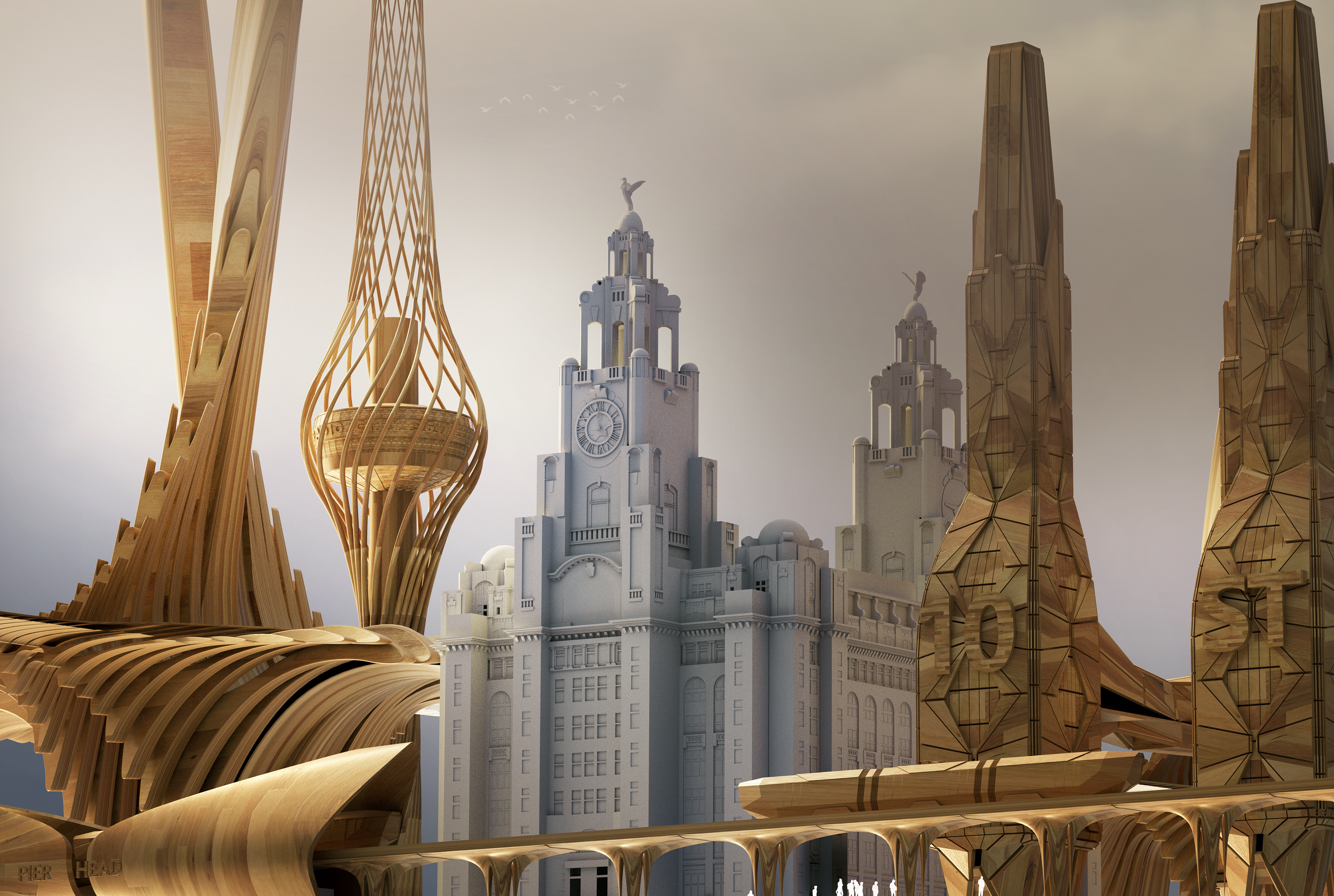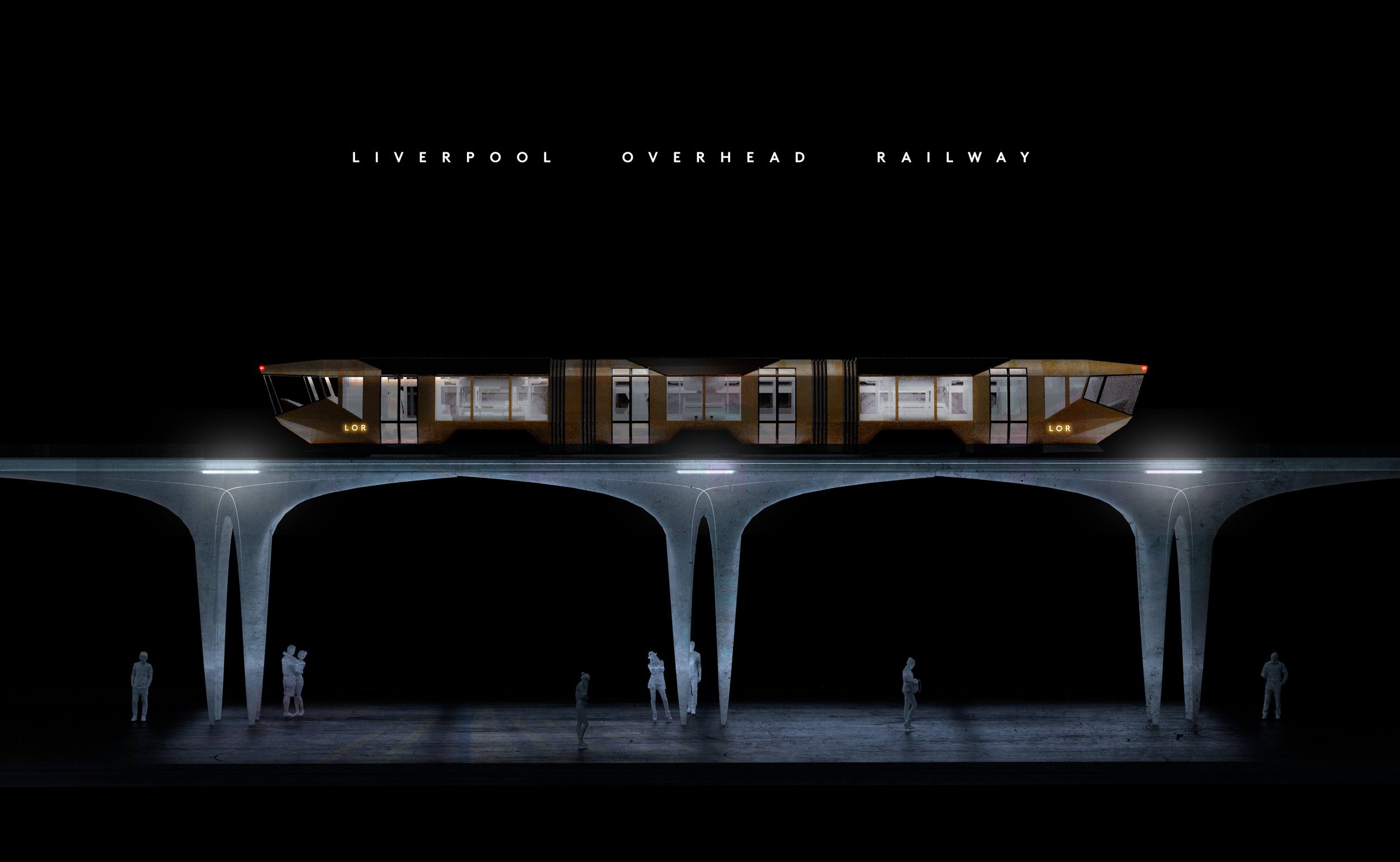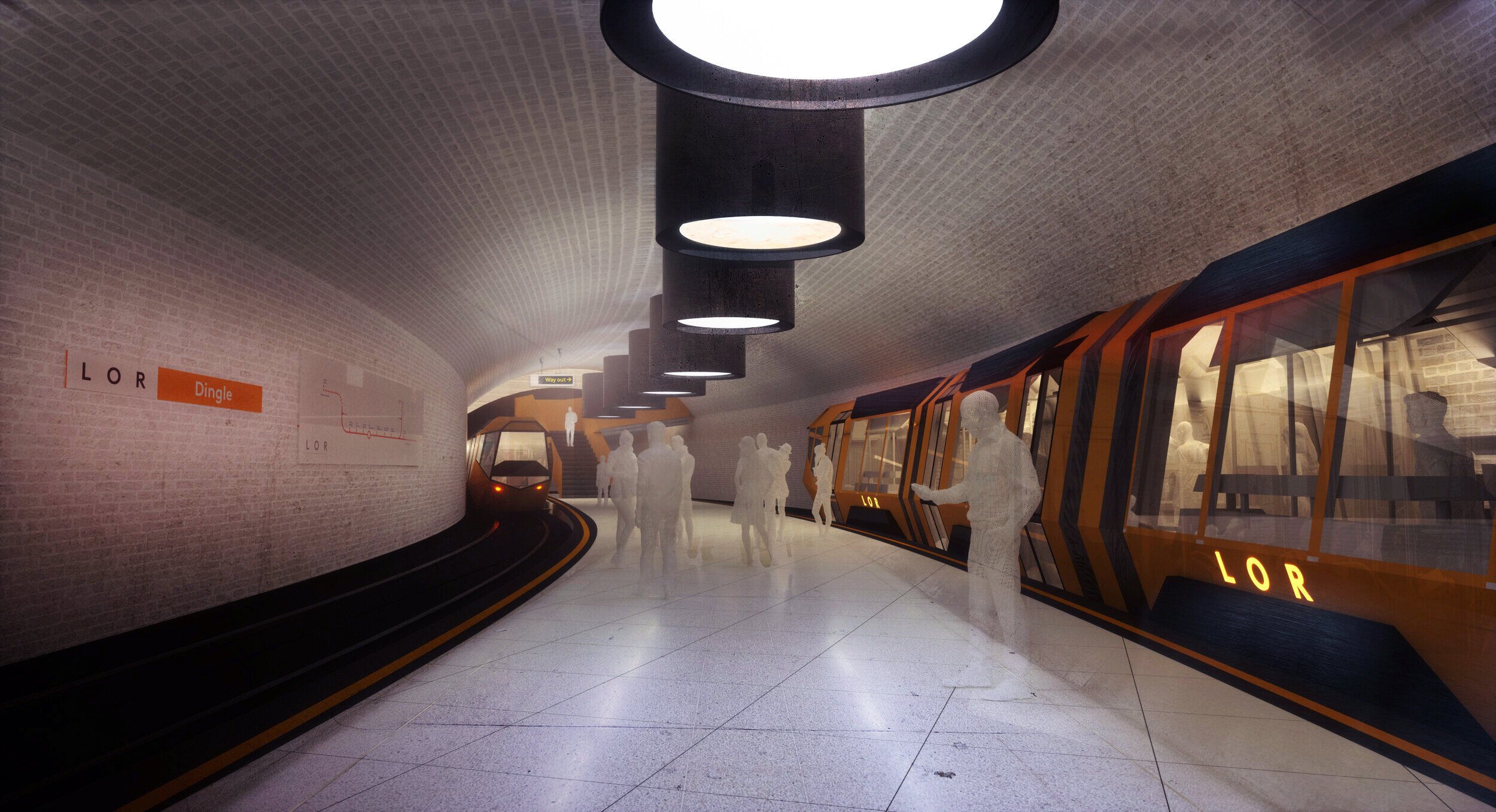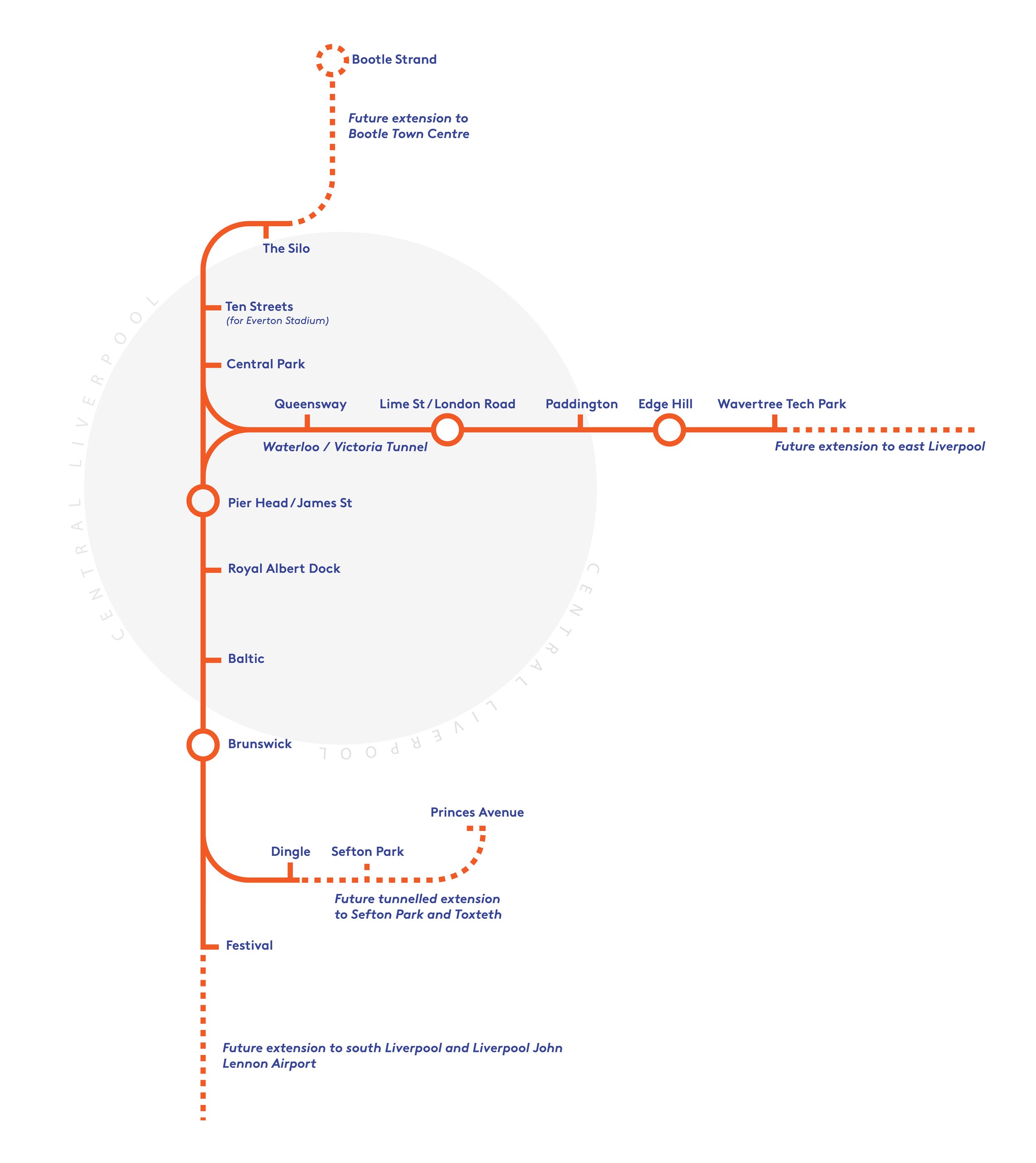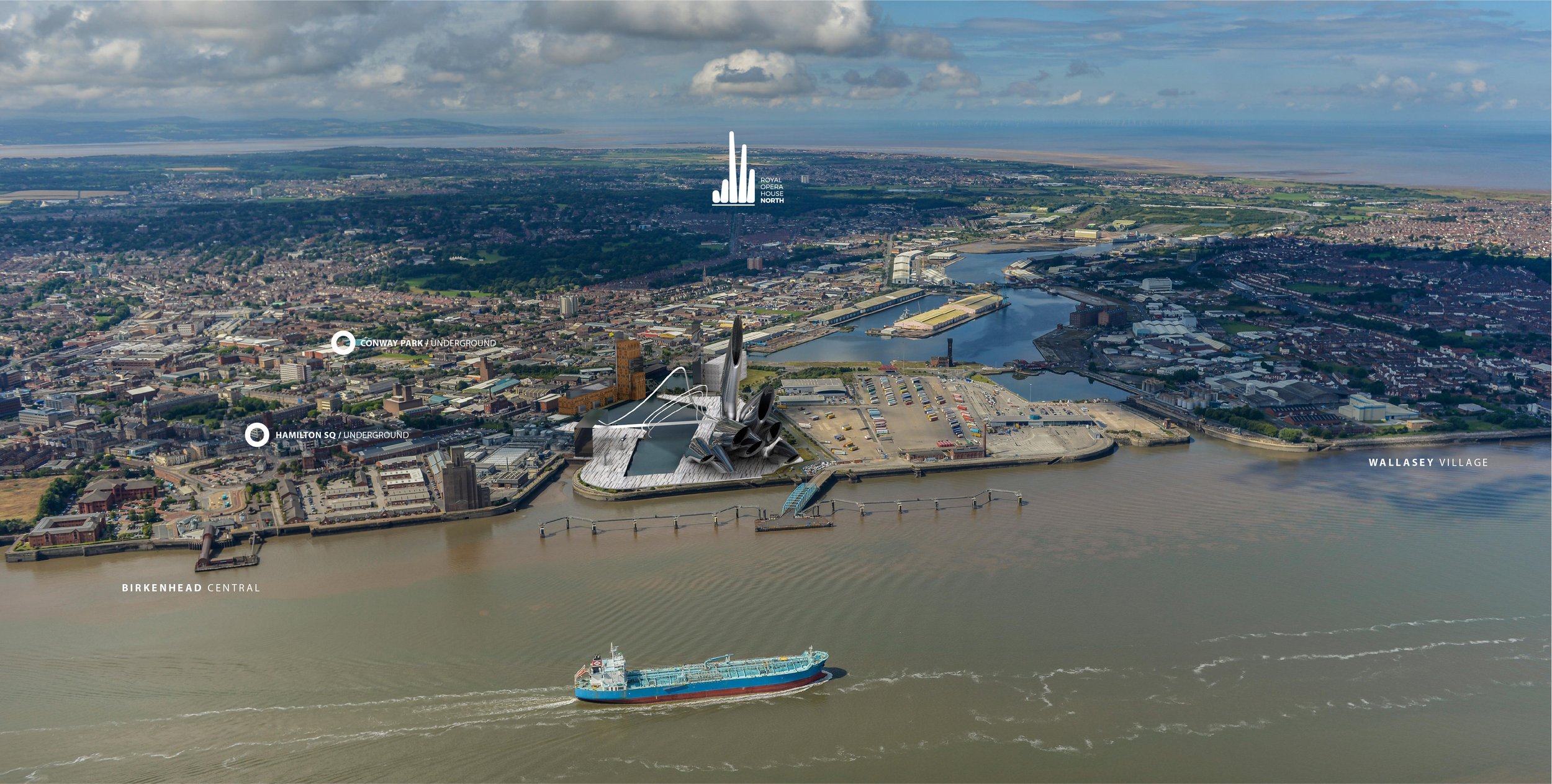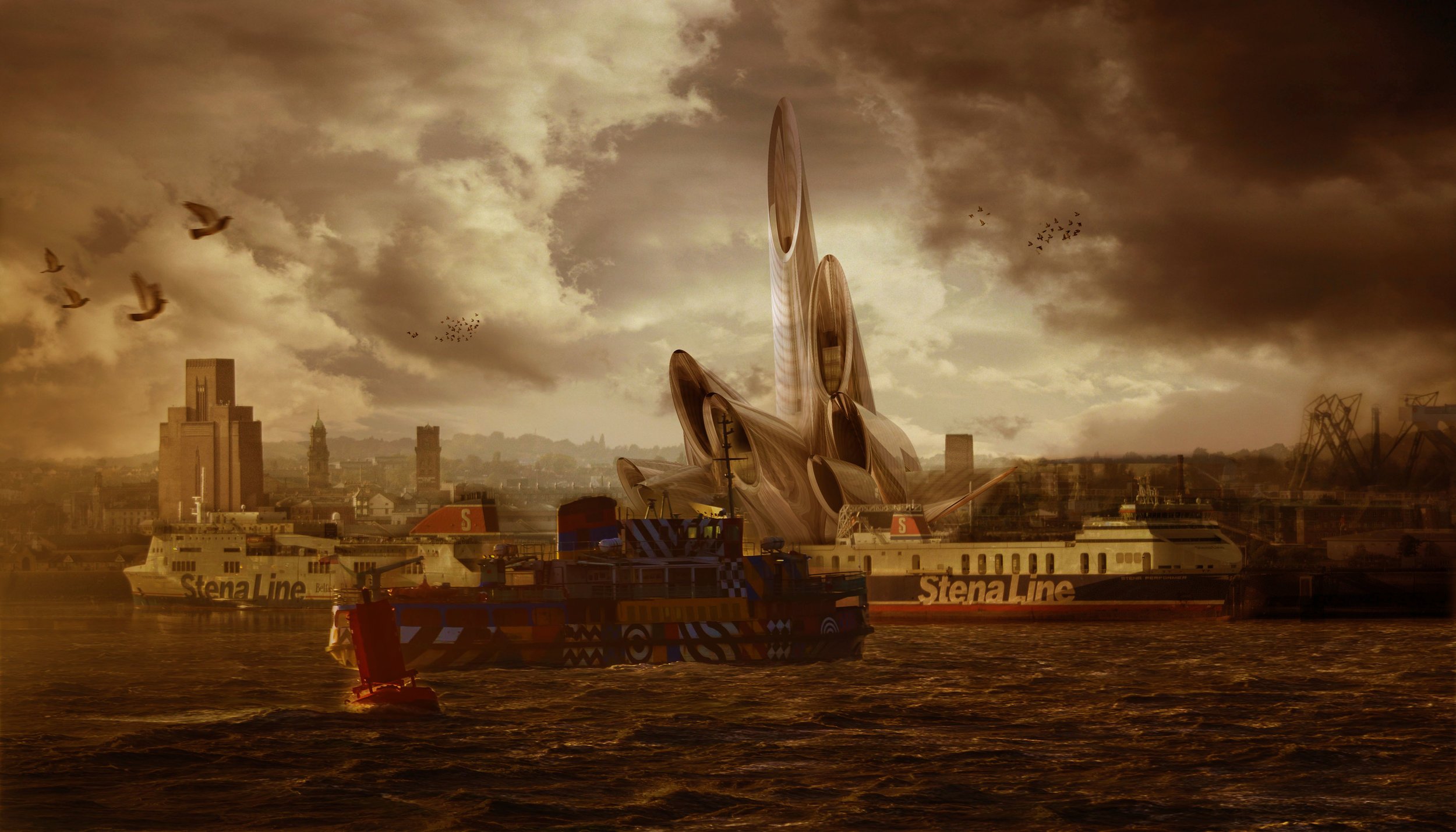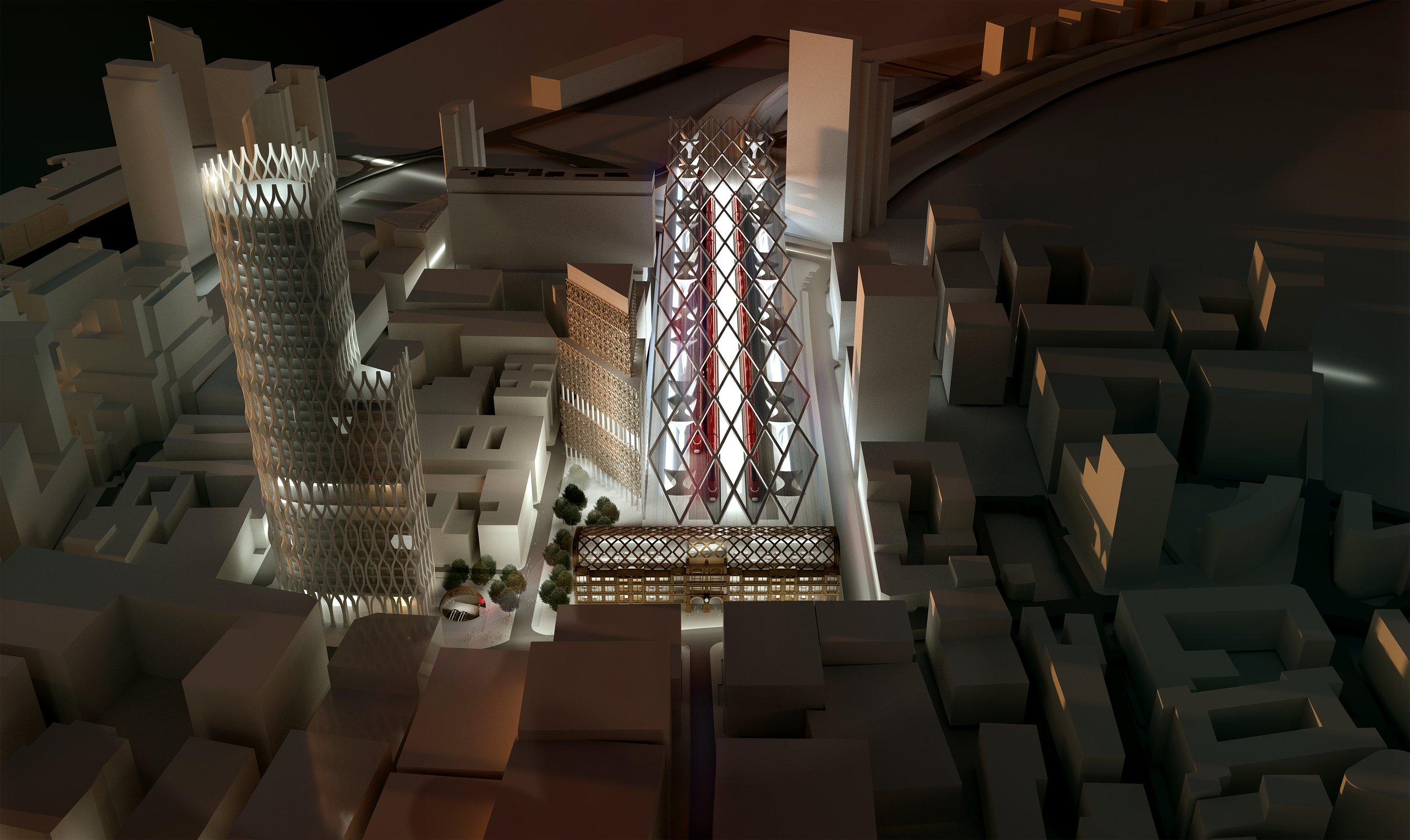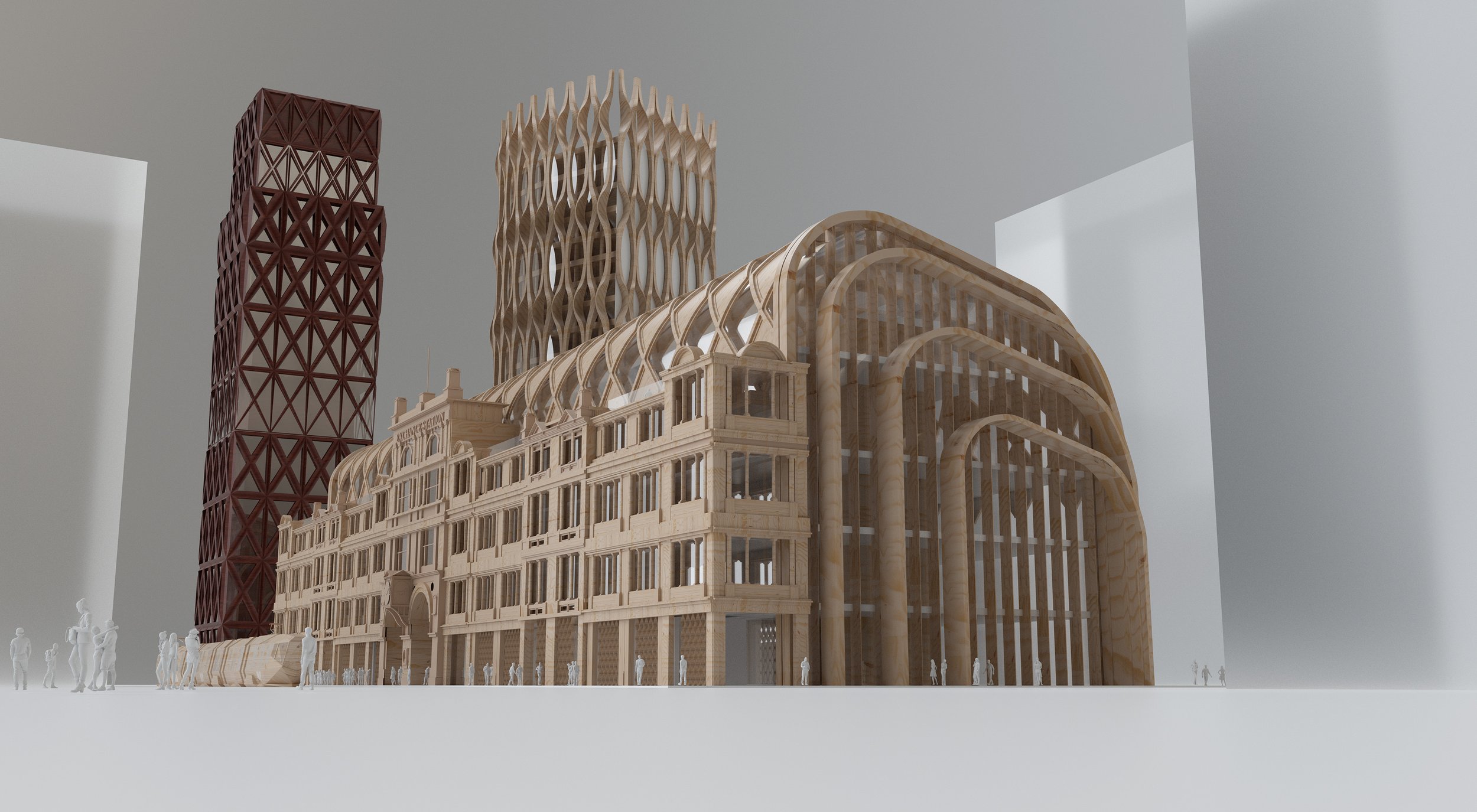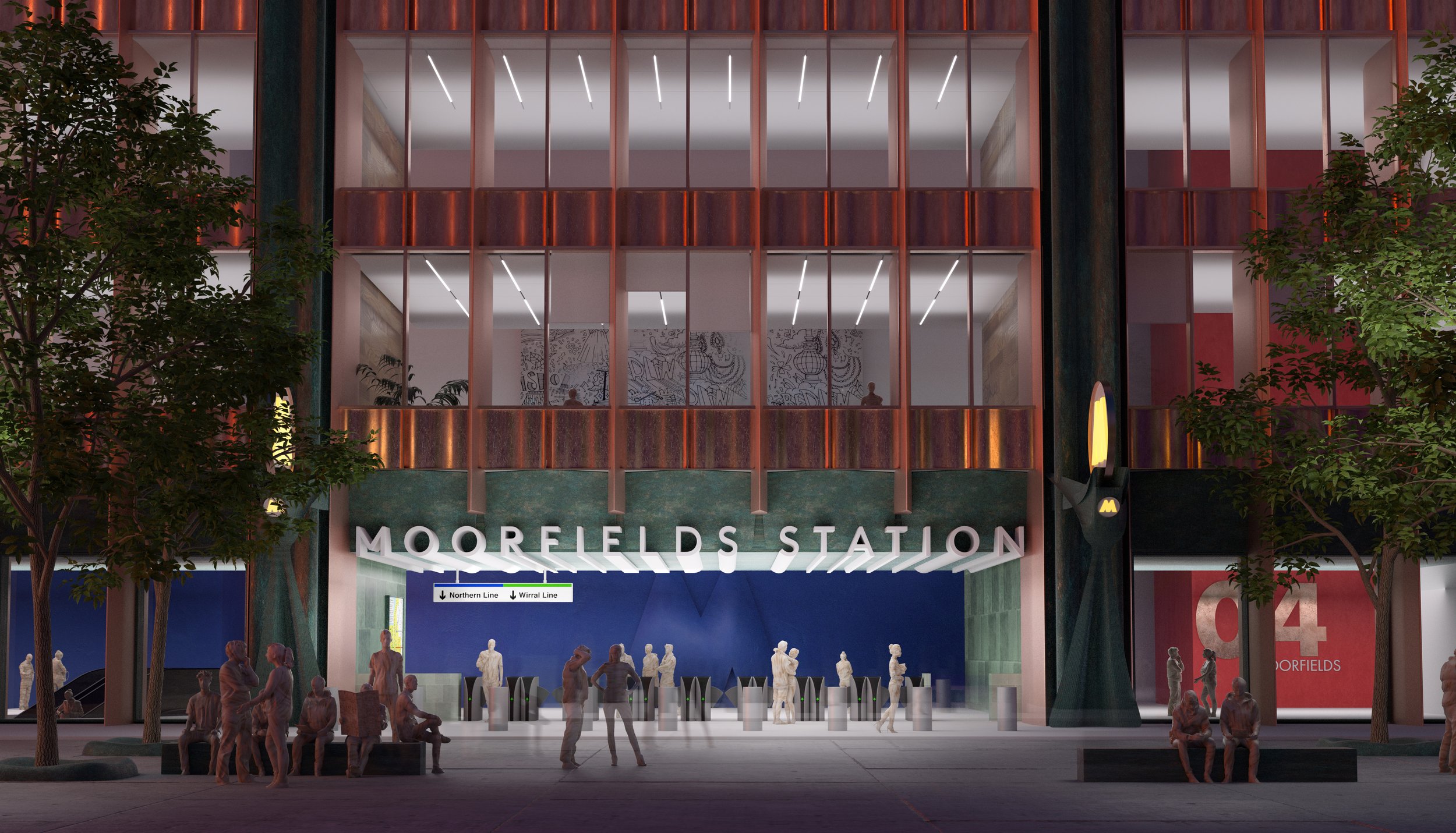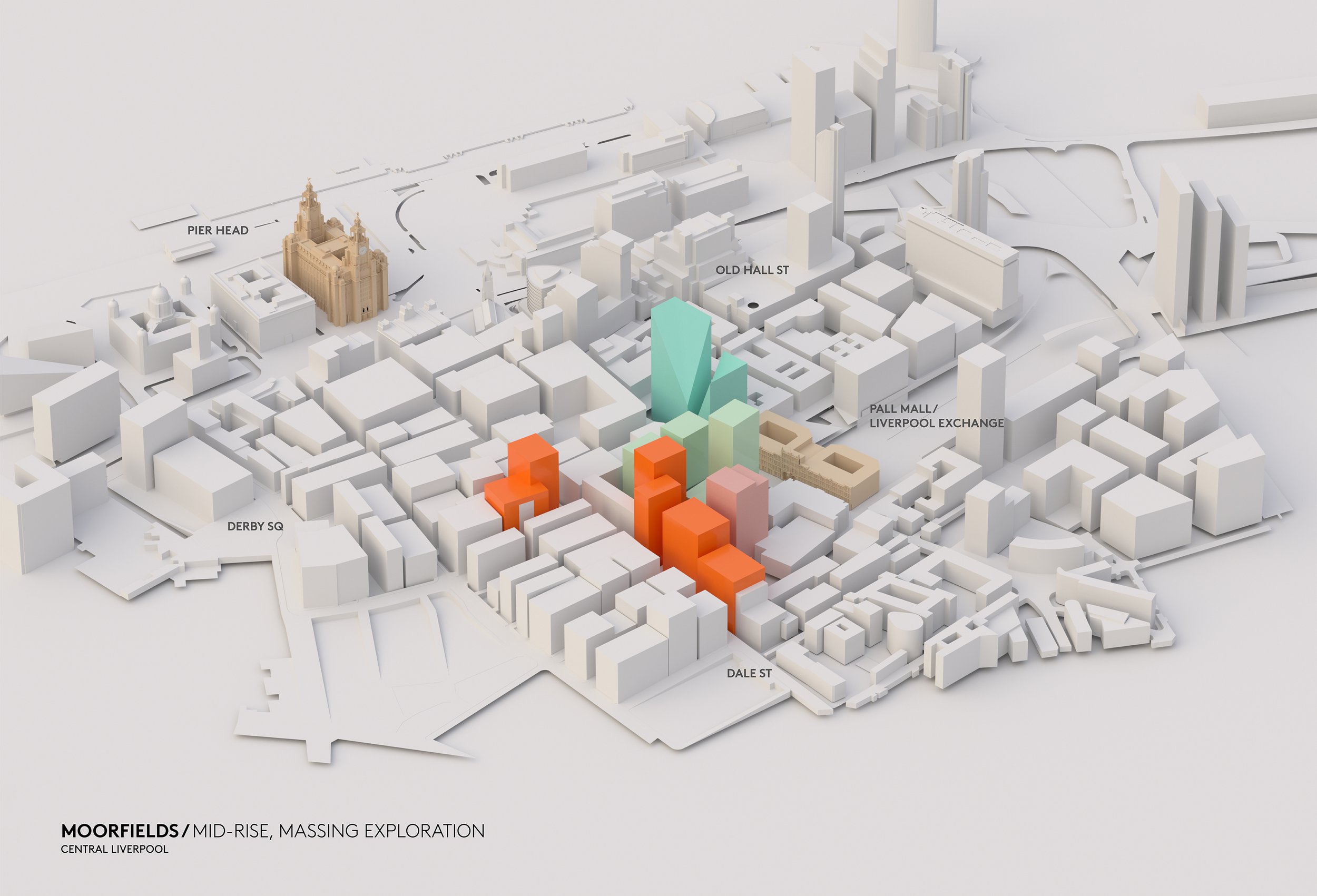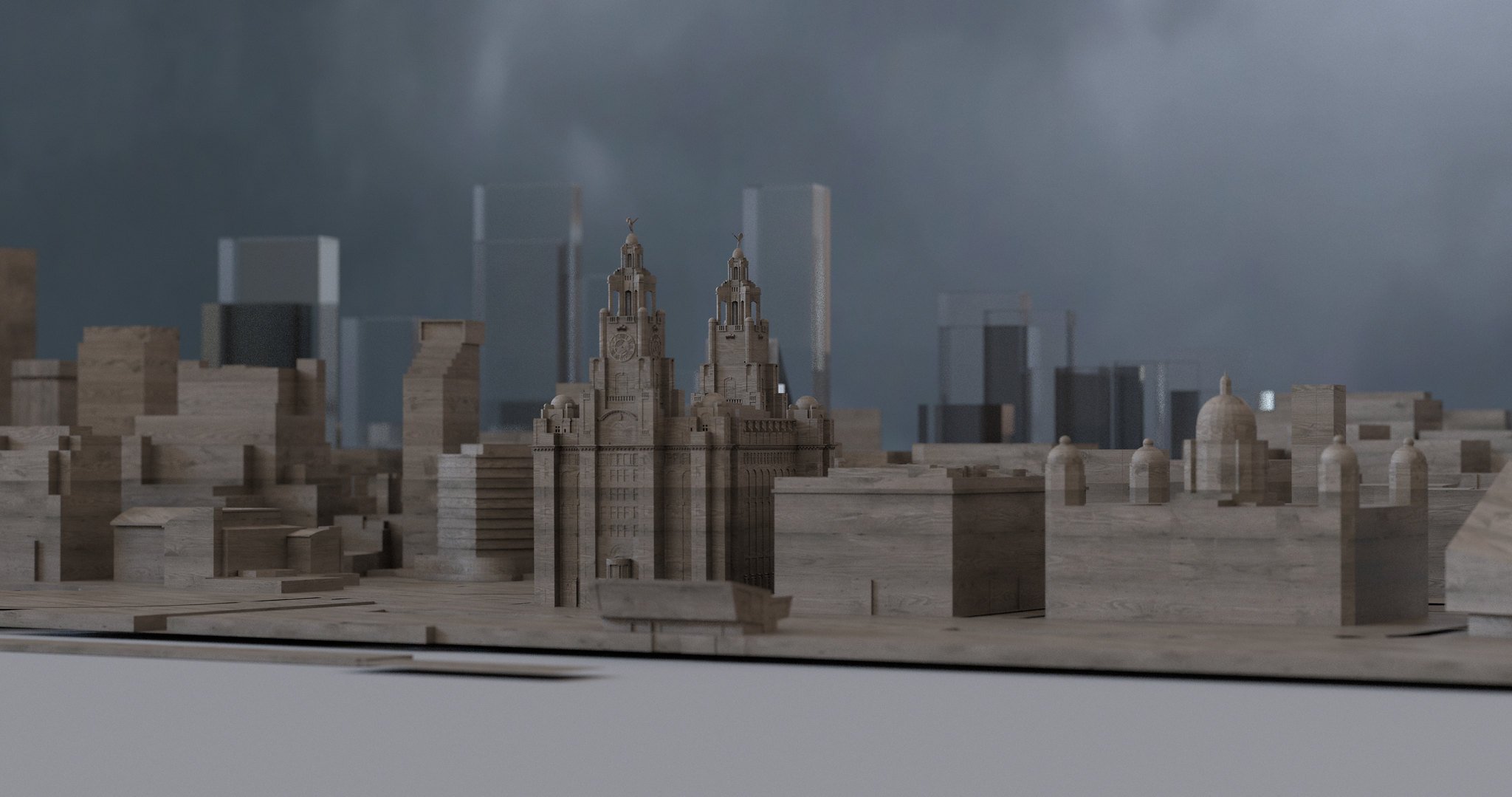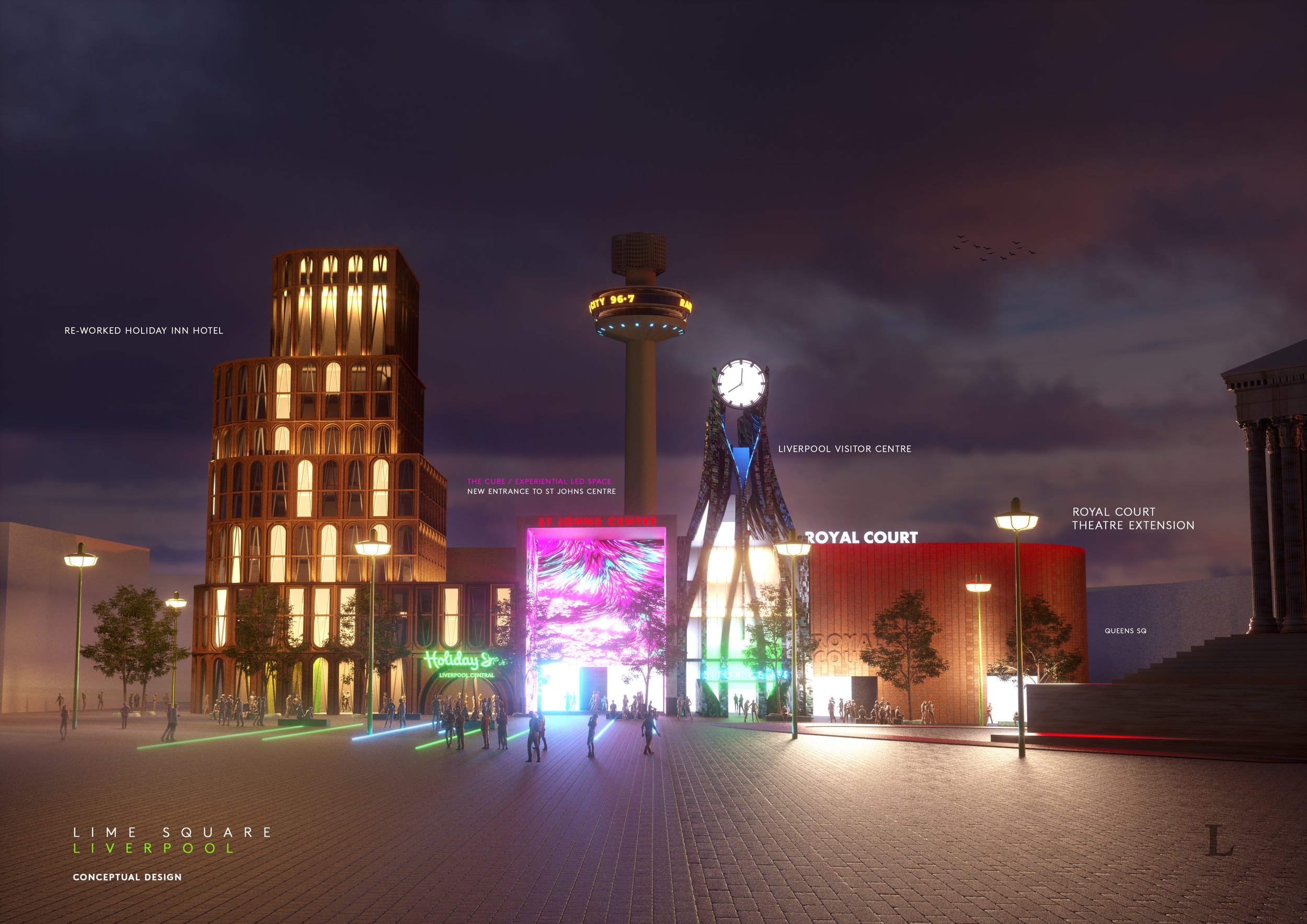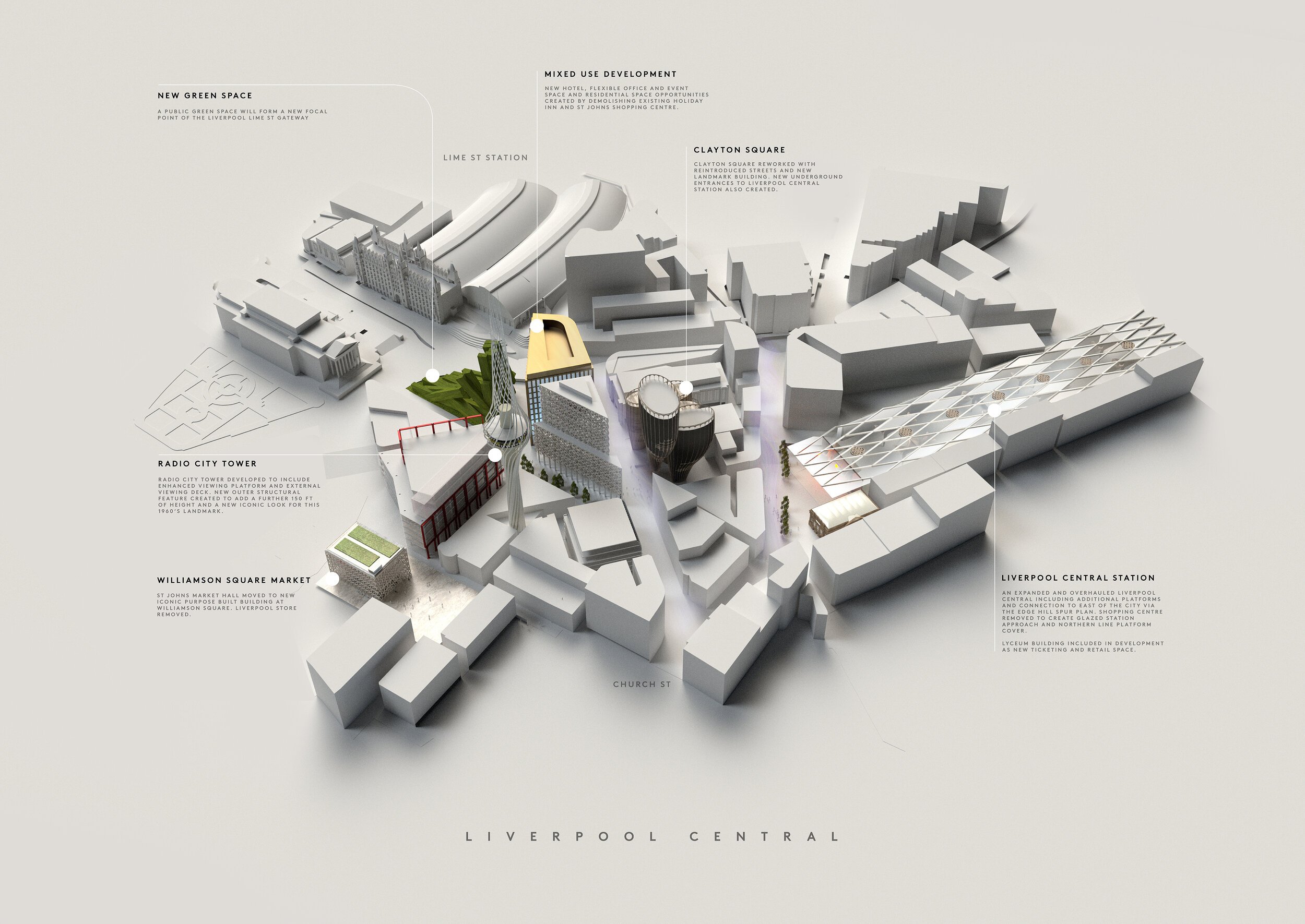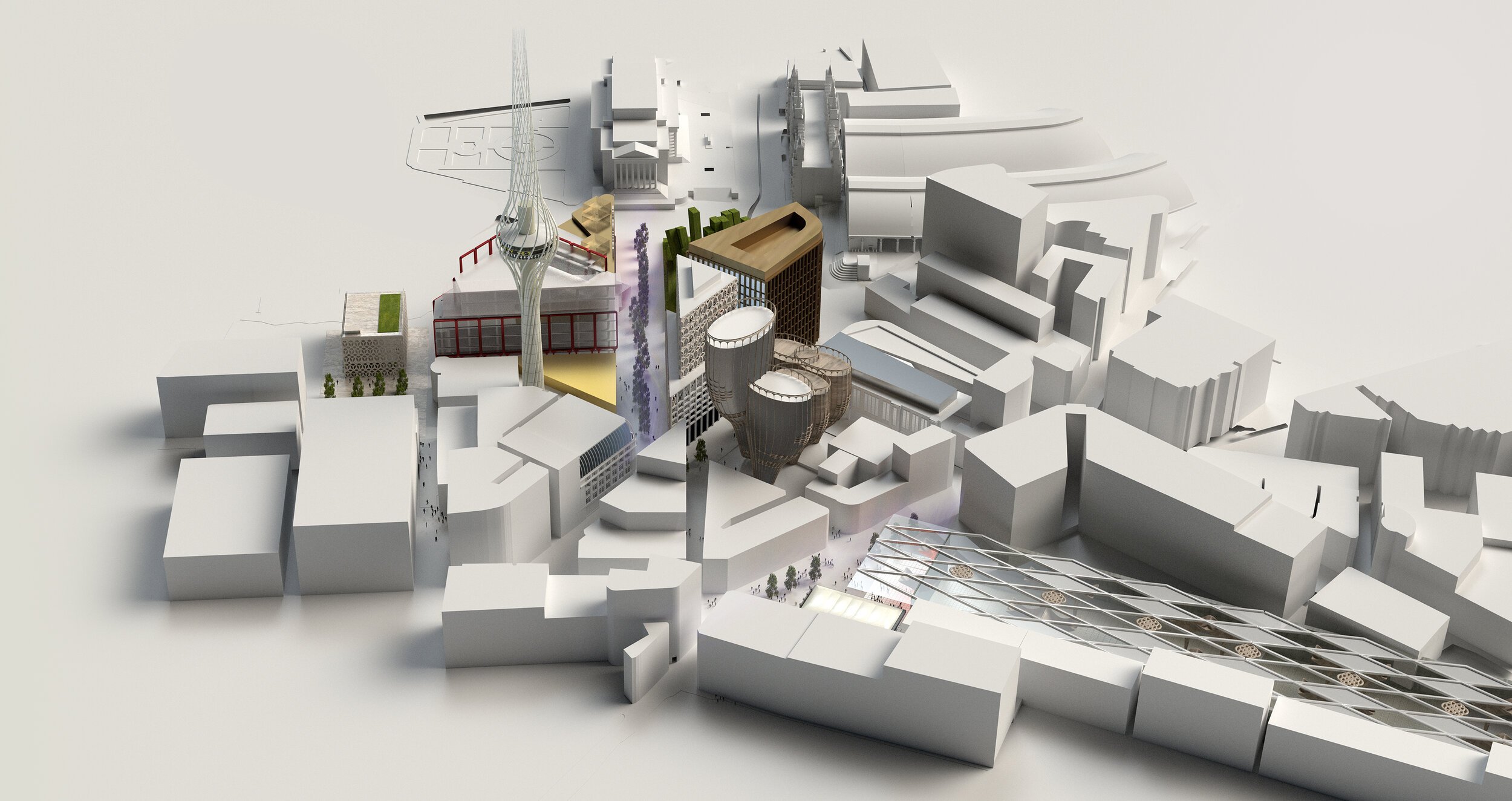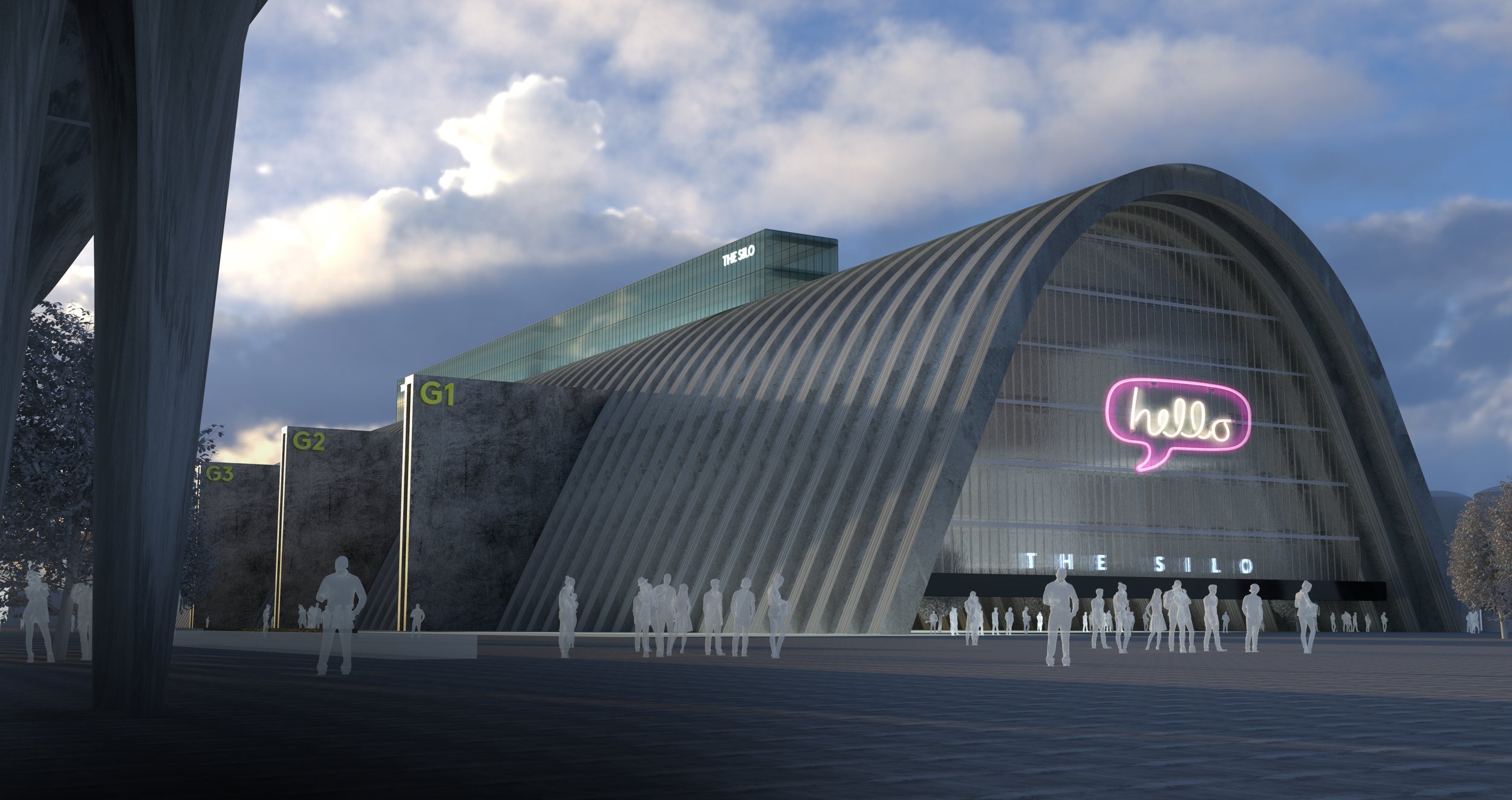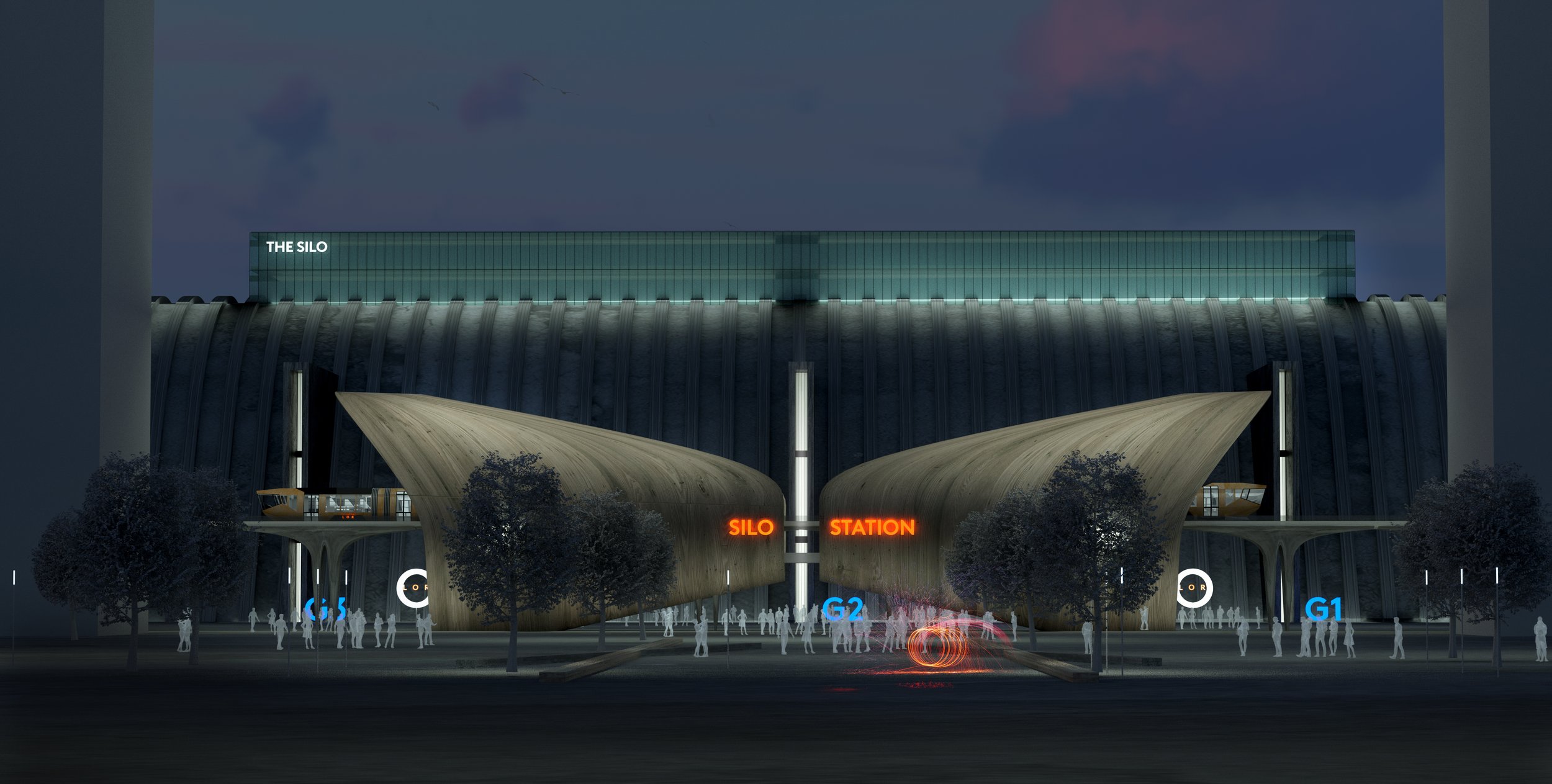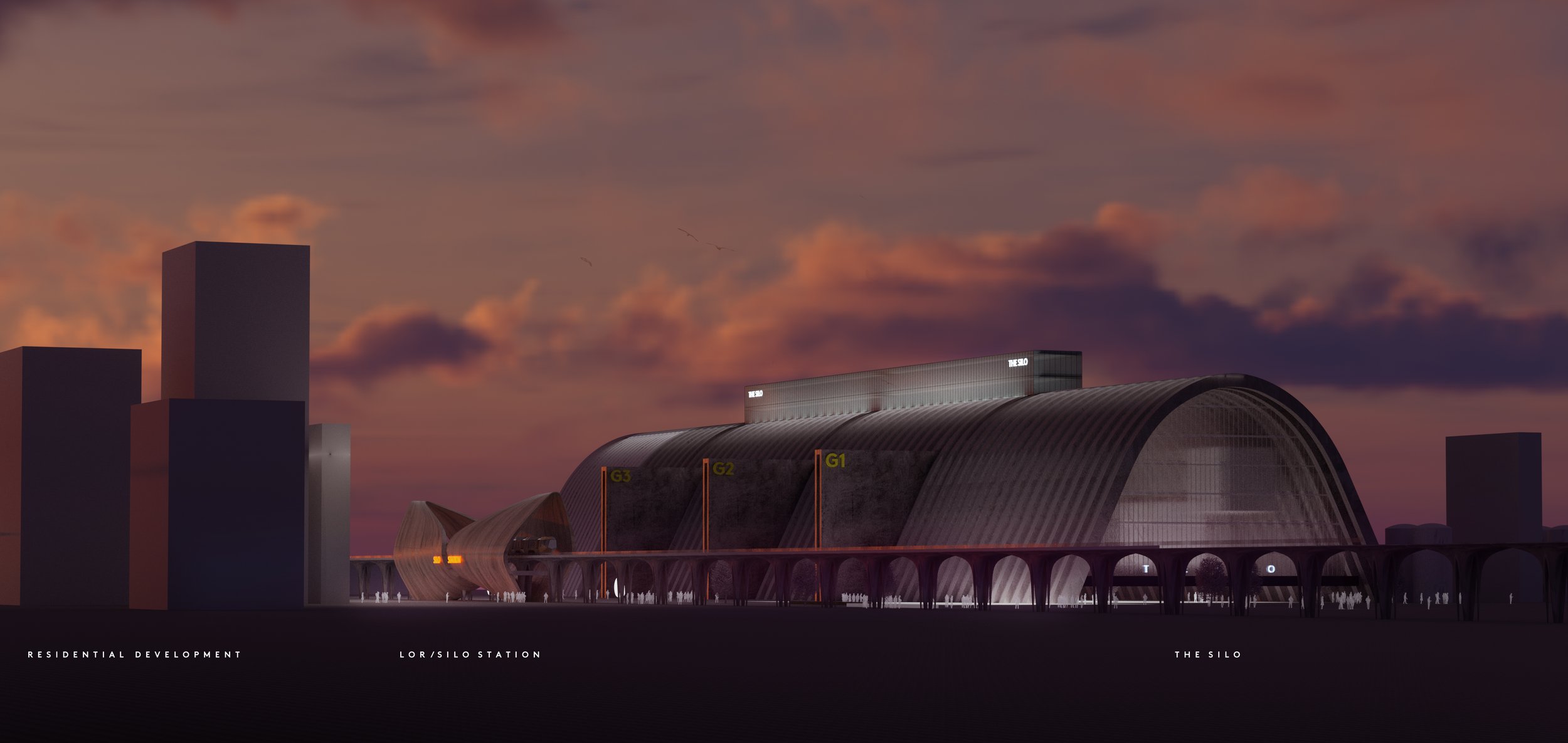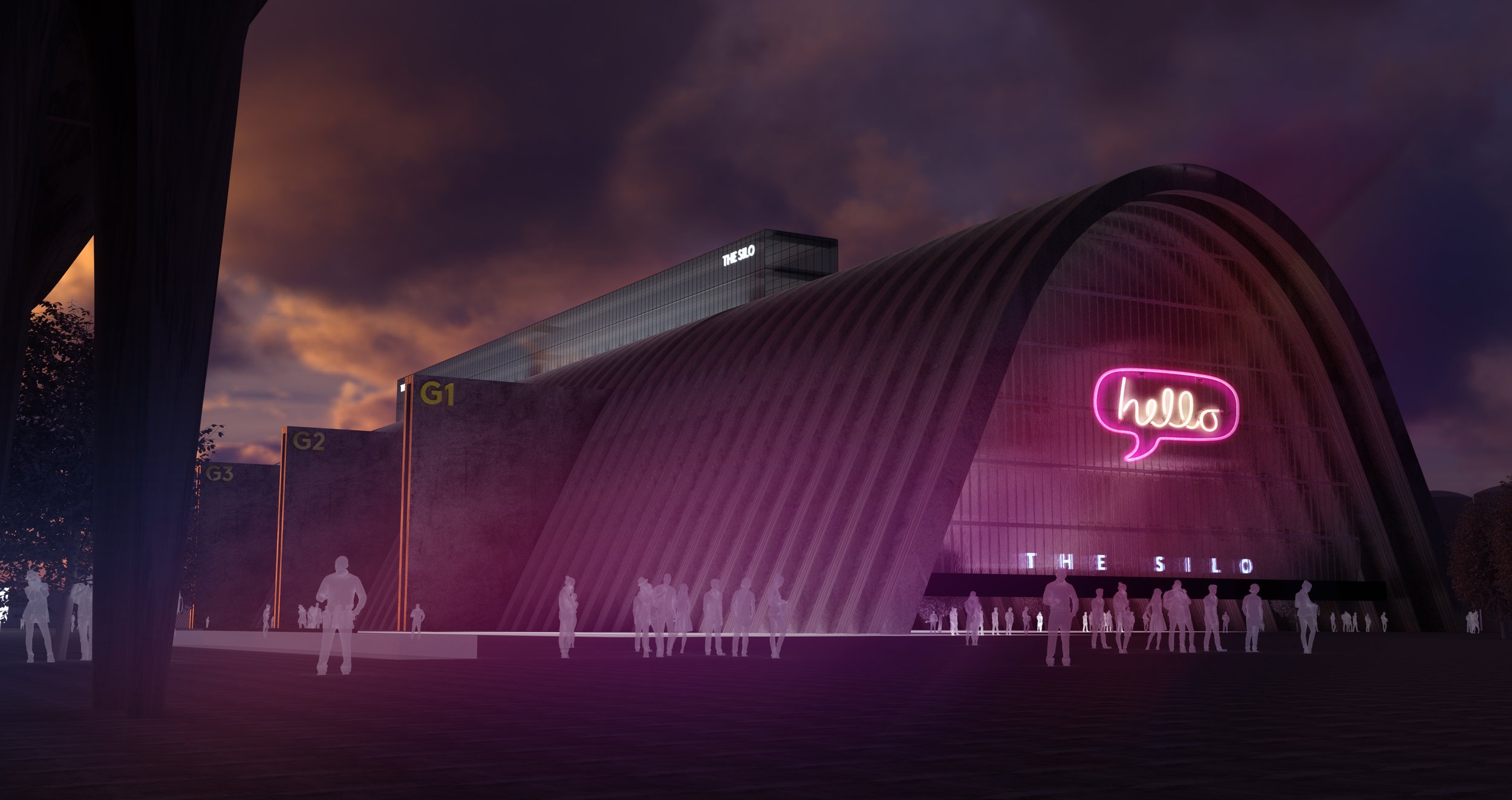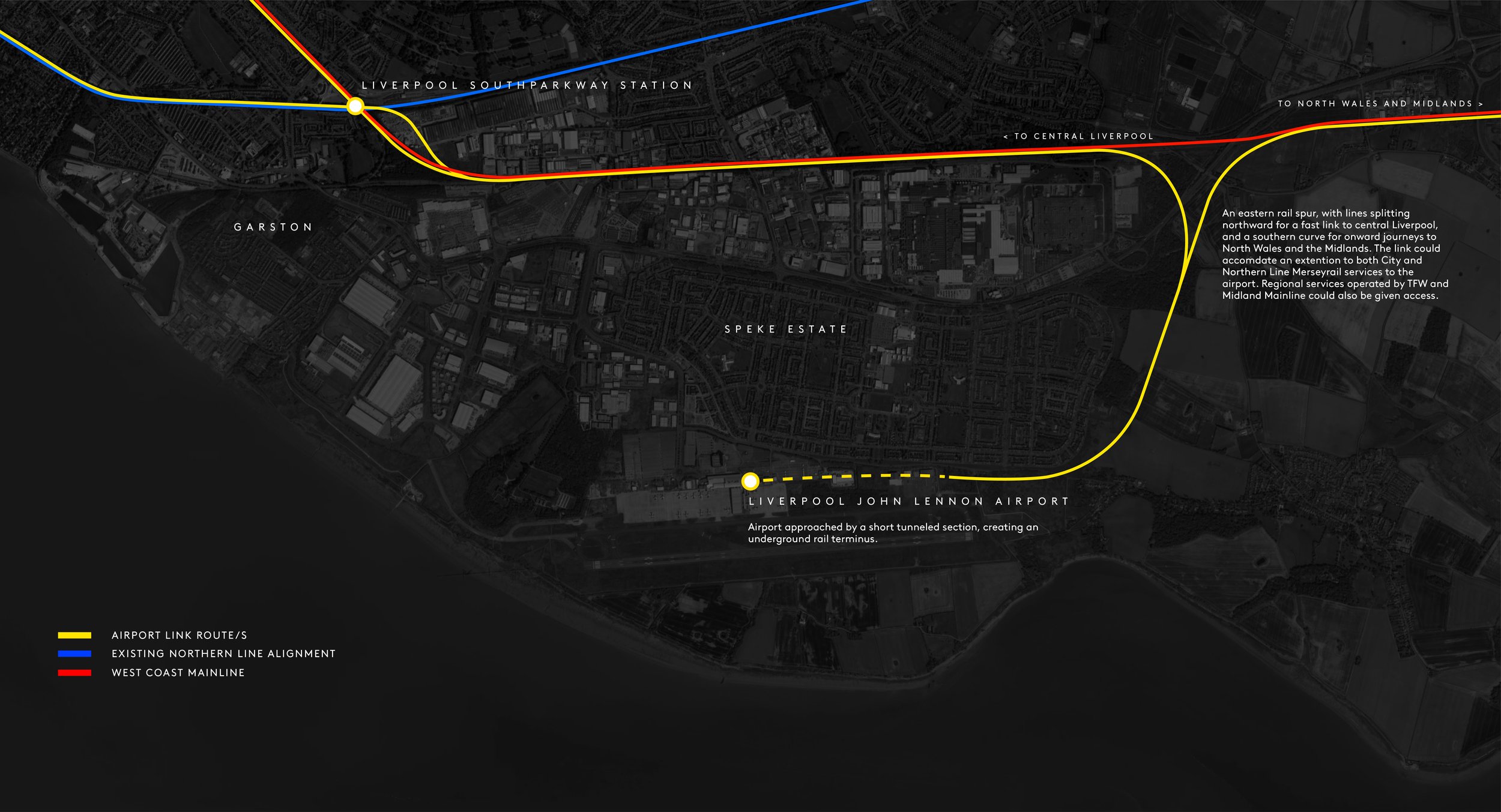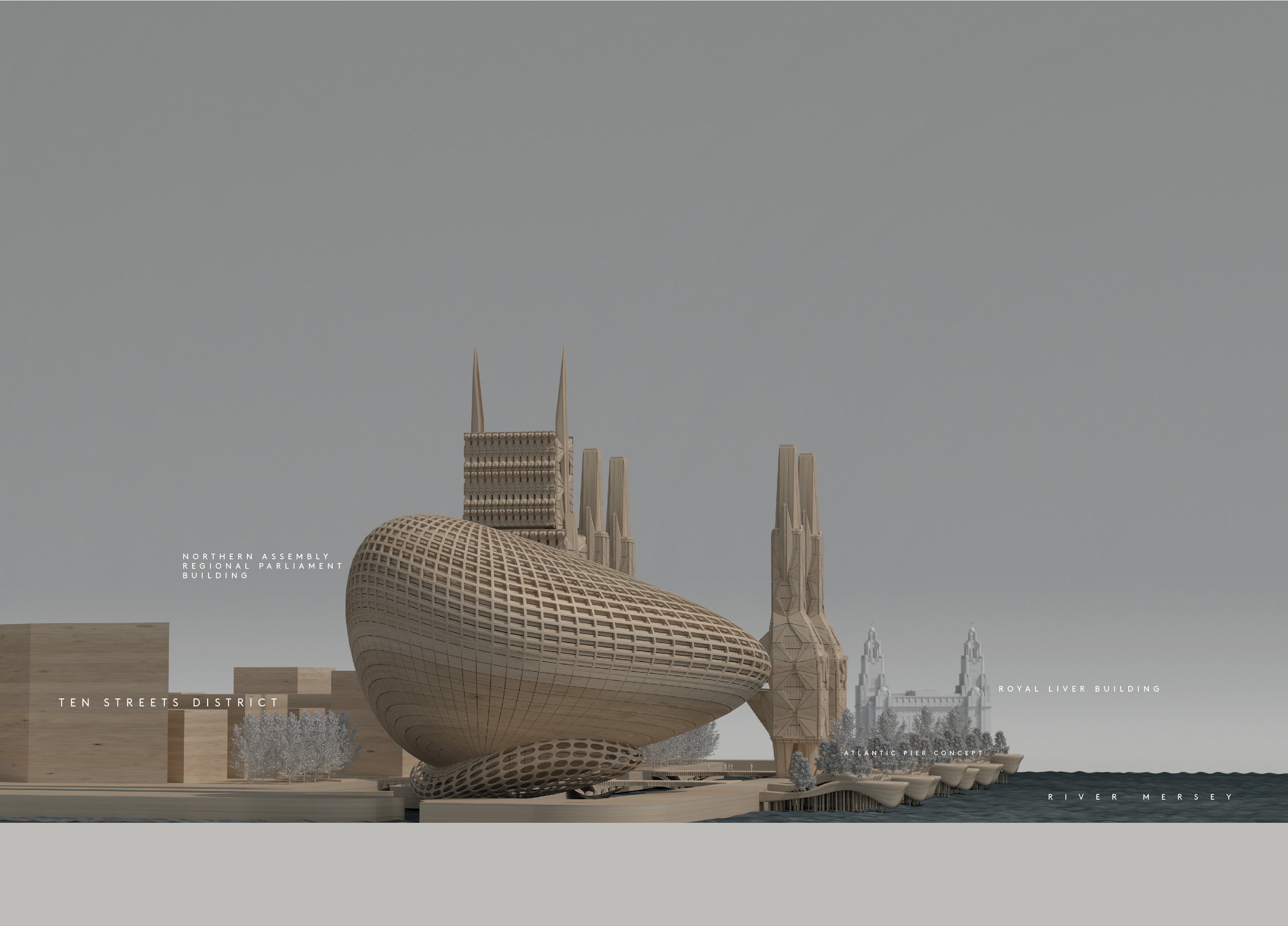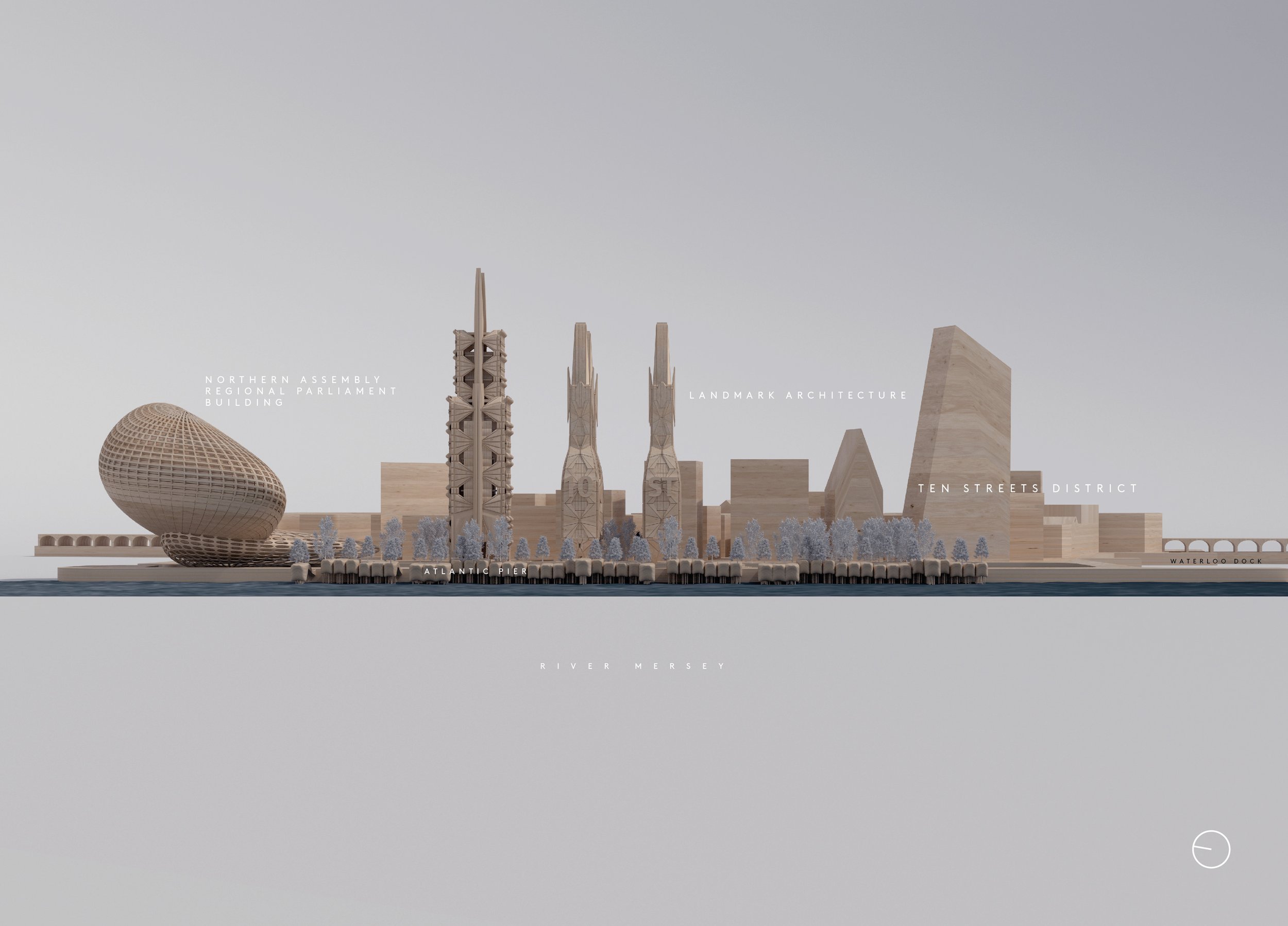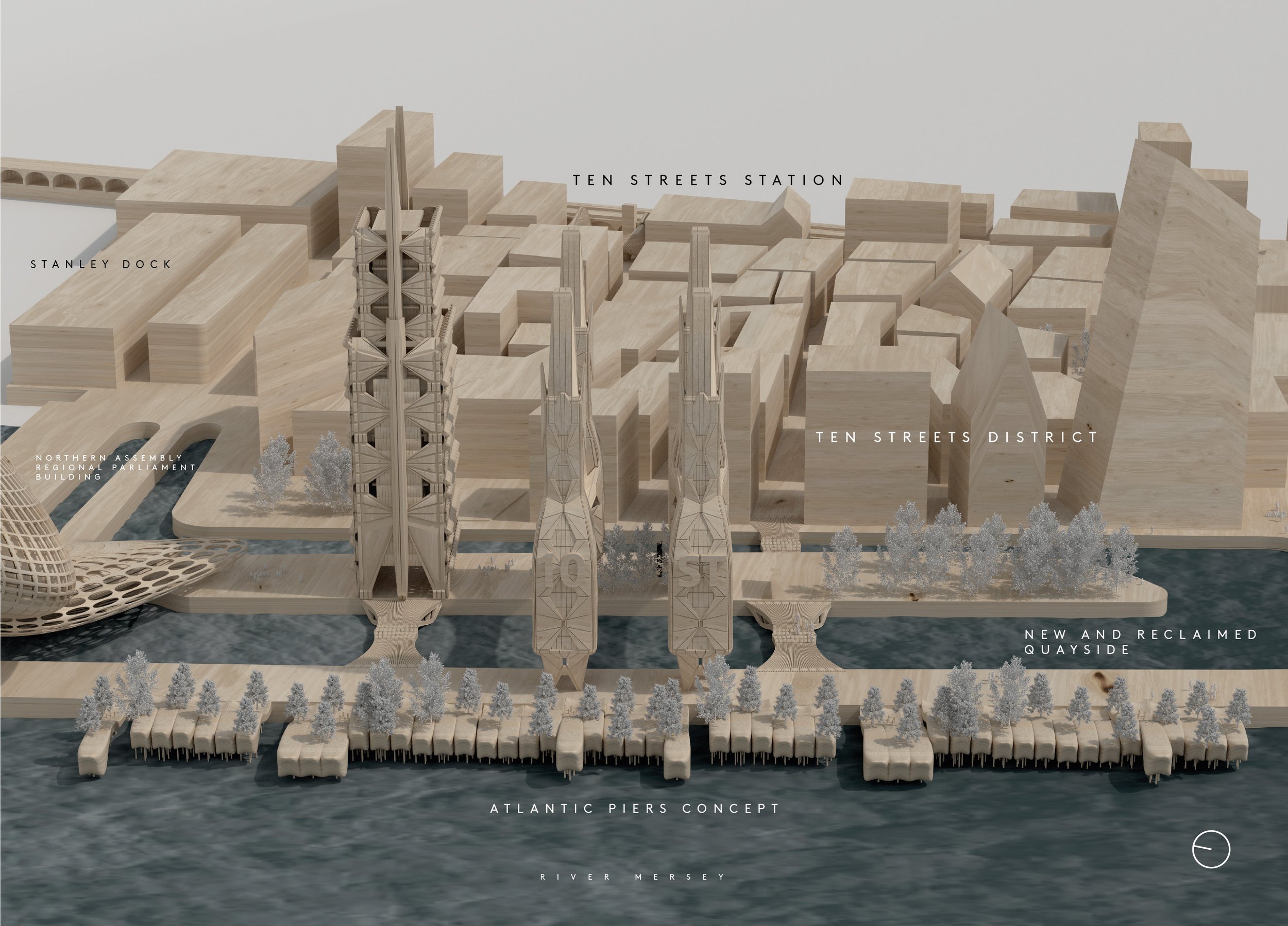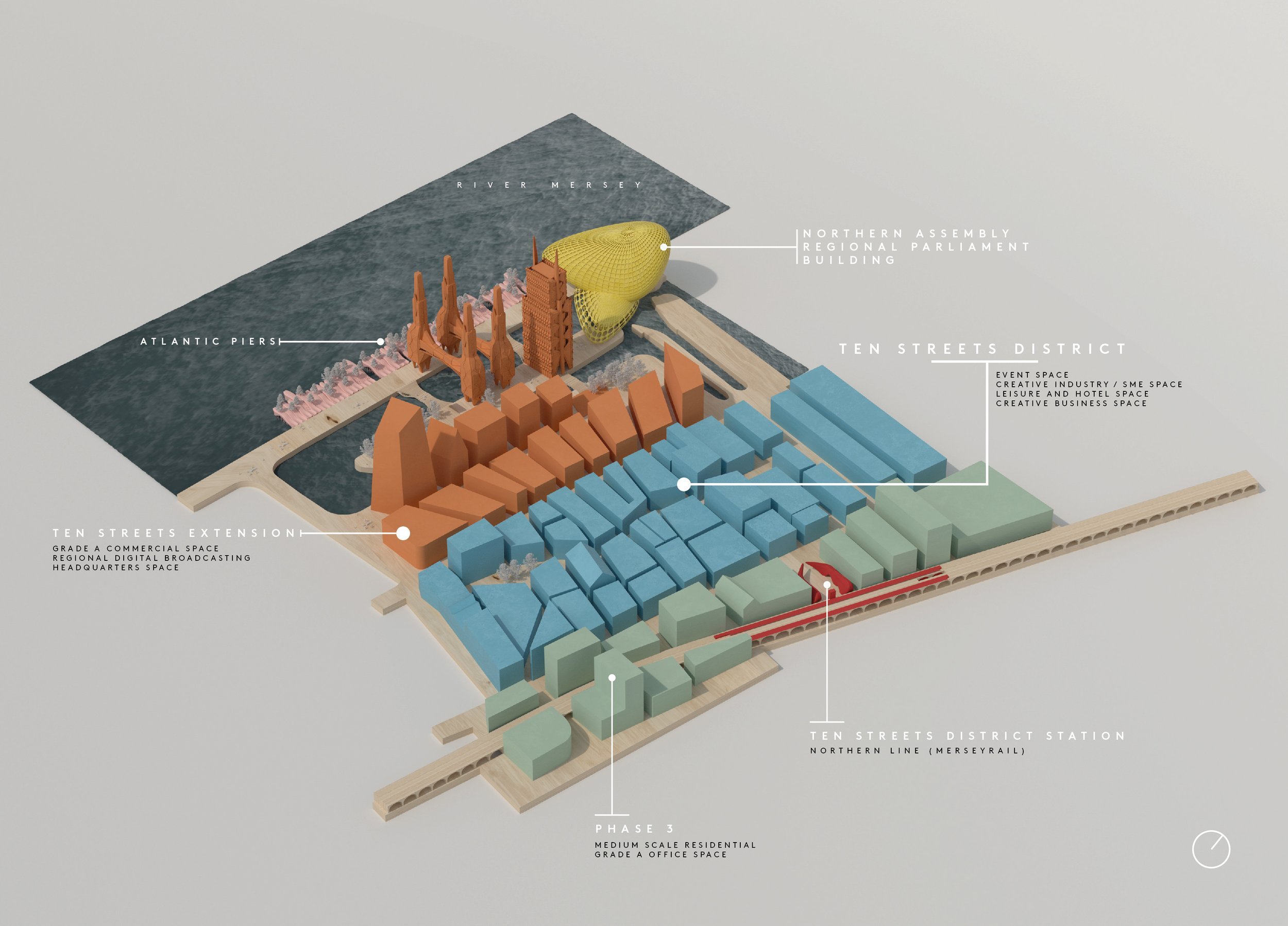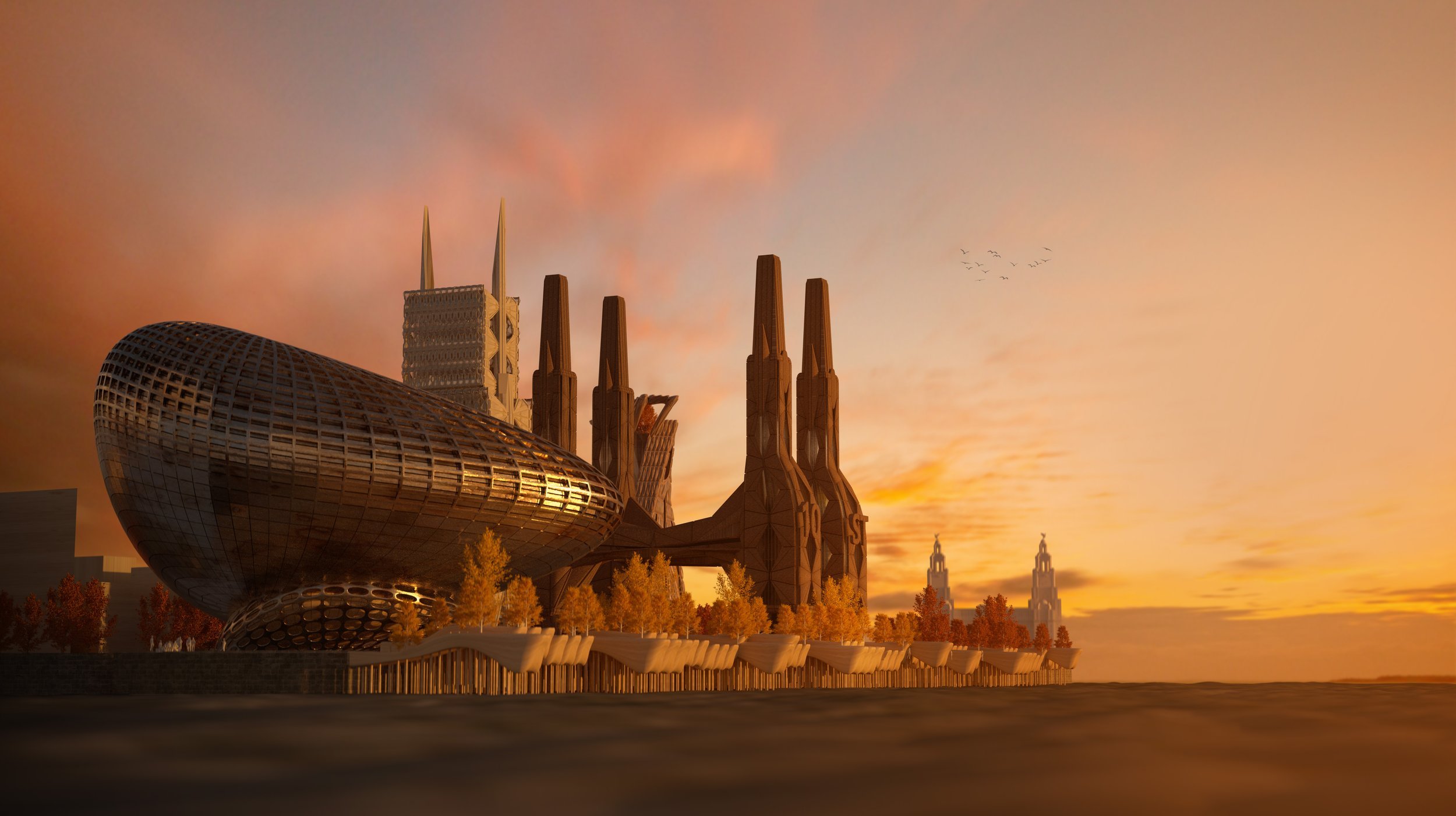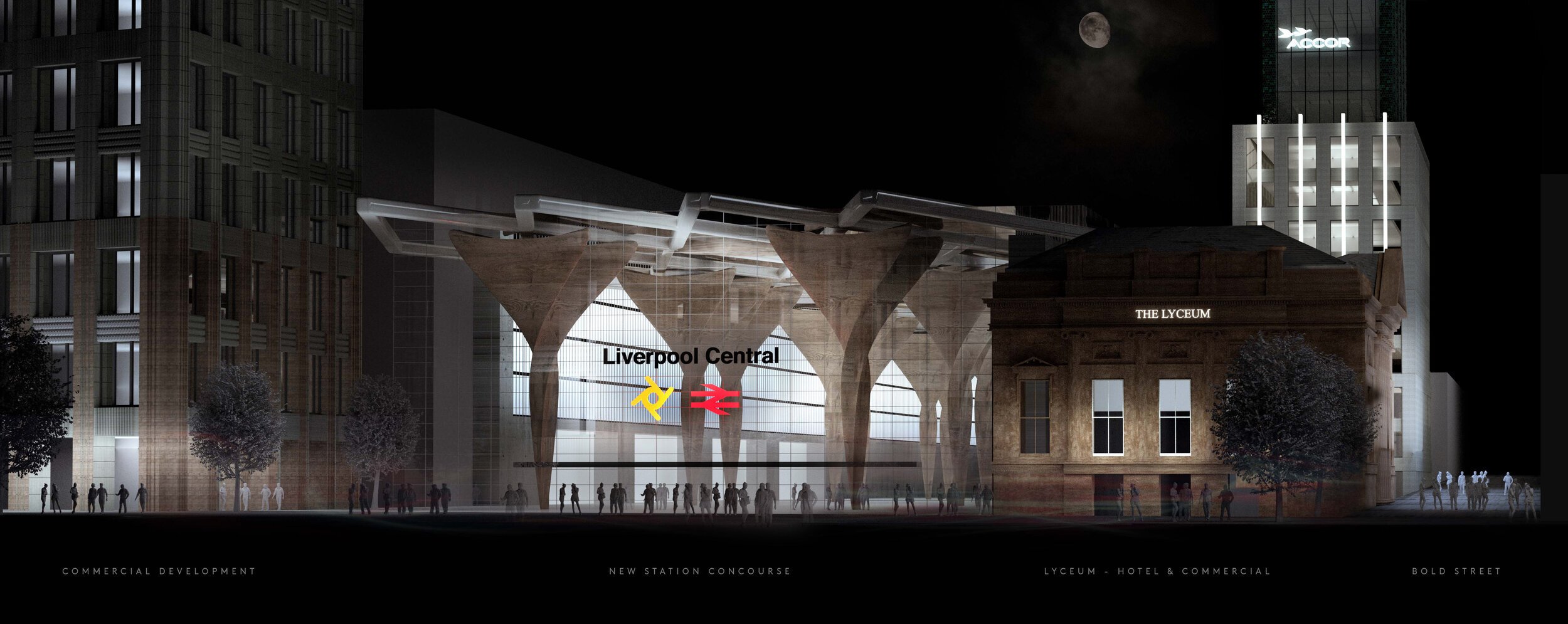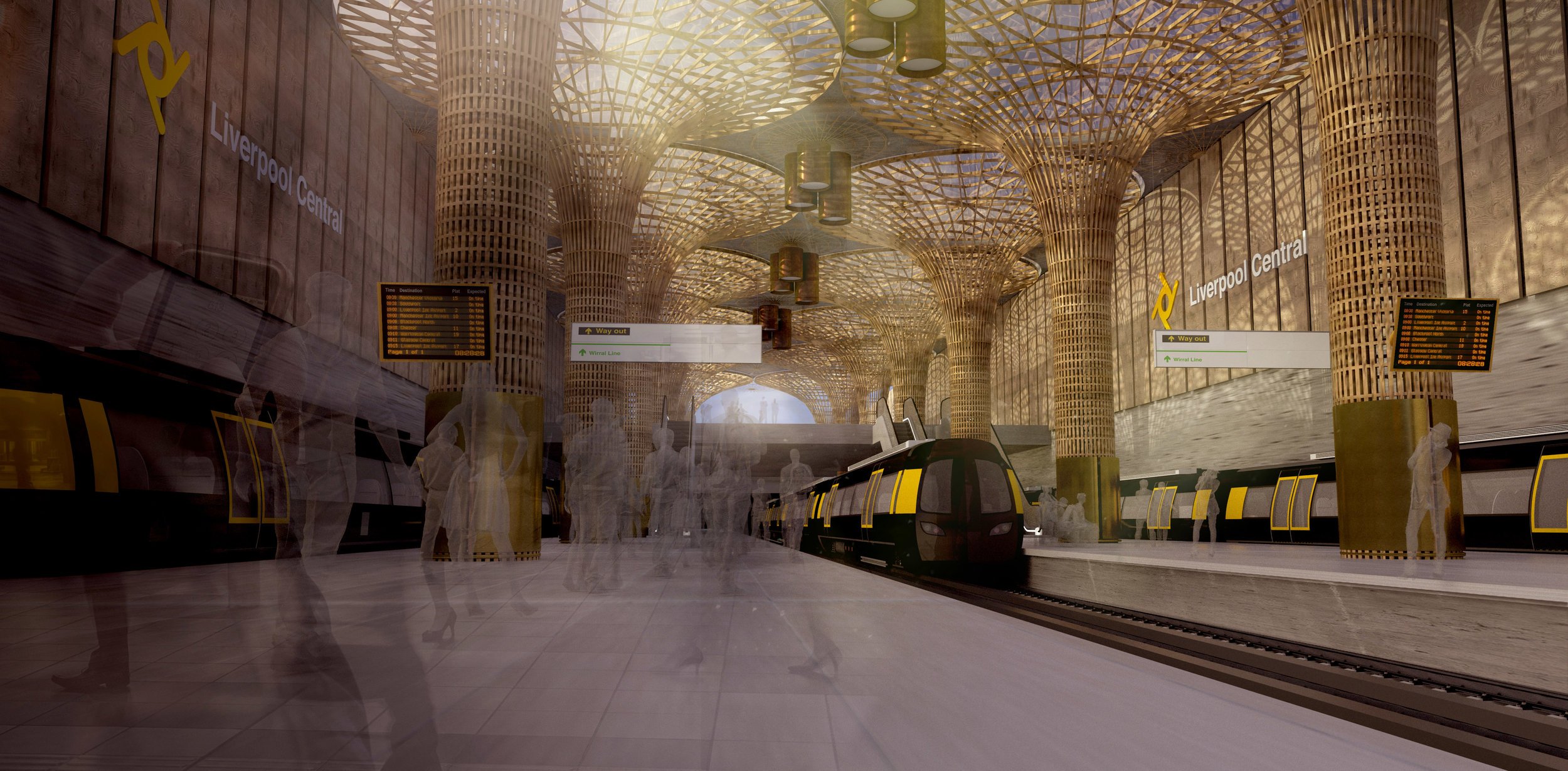Recent features
Ye Wha? Opera on the Mersey and other Mad Visions
For over ten years, 3D animator Michael McDonough, has been dreaming up new ways to re-imagine Liverpool’s urban landscape – designing outlandish opera houses, cathedral-like train stations, gothic bridges, and new visions for the docks. None of them have been built or are ever likely to be. But why does he bother? In this showcase of his work, Liverpolitan Editor, Paul Bryan explores Michael’s fascinating dreamscapes of the imagination.
Paul Bryan
“The way I come at things is to make no small plans. The city has had too much of that, too much dross, too much crap, too much small time thinking.”
So says Michael McDonough, Co-Founder here at Liverpolitan, and a man who has developed a bit of a reputation for his outspoken criticism of Liverpool’s (lack of) development scene. And in fairness, it’s a view that I, as the magazine’s Editor, often share.
One of the things that makes Michael interesting to me (other than the fact he’s had to develop skin as thick as a rhinosaurus to bat off ‘the army of gobshites’ who take him on or even pose as him online) is the fact that despite a successful career as a 3D designer and animator which has taken him to the capital, he continues through his design work to try to make a positive contribution to his home city of Liverpool and the discussion about its future. He does this without fanfare or gratitude and in fact, often in the face of quite complacent criticism from ‘locals’. Often by people with far less talent or insight than himself. For over ten years now, entirely under his own steam, Michael has been dreaming up new ways to re-imagine Liverpool’s urban landscape – designing outlandish opera houses, cathedral-like train stations, gothic bridges, and new visions for the docks. None of them have been built or are ever likely to be. They are not fully formed architectural plans, more dreamscapes of the imagination and we’ve made a showcase of that work in this feature article.
But why does he bother? What’s the point? Aren’t they just castles in the air built before AI and Midjourney made fantastical images the prerogative of all? To believe so would be to miss what’s really going on. There’s a much harder edge lying beneath the glossy visuals. He’s making the case for ambition as an antidote to a city-wide loss of nerve.
“We should be thinking in the same way world cities do like London, Singapore and New York. All these places have big ambitions. We should be looking to emulate that,” says McDonough. Instead, he believes Liverpool increasingly seems resigned to a lower status and too often its mediocre plans reflect that. Small schemes are favoured over transformative ones and then heralded as being the way forward. Anything substantial or showy is typically treated with hostility and suspicion.
“I keep hearing that in Liverpool we’re different, that we have our own models of success, but it’s a language of defeatism, masked and airbrushed as some kind of urban superiority.” He rejects this idea totally. “Being different doesn’t mean you reject ambition, scale and big ideas. That doesn’t make you different, it just makes you stupid.”
‘There’s an obsession in Liverpool’s planning circles with ‘context’ – the idea that new developments must be submissive to the city’s crown jewels."
Michael’s designs are meant in sharp contrast to the veritable cottage industry of ‘place-making’ peddlers, much favoured in recent years by our city leaders, whose low aspiration output chimes with this defeatist mindset. Meanwhile, the same old local architectural practices win job after job, churning out budget off-the-shelf buildings that further erode what makes the city special. There’s an obsession in Liverpool’s planning circles with ‘context’ – the idea that new developments must be submissive to the city’s crown jewels. But that attitude just results in bad buildings and Michael’s designs deliberately shun such restrictions. Some of his designs will inspire, but also enrage.
“The irony,” says McDonough, “is that those buildings we love so much are there purely because of ambition, because of power and commerce. They didn’t just land there as gifts from God.”
The point of history is to learn from it, not to fetishize it. We do Liverpool’s history a disservice by feeble attempts at mimicry. The Liverpool of yesteryear was bolder and more global in its perspective and if we are to take something useful from the past, it should be that. What Michael is attempting to do with these designs is to remind the city that it’s capable of bigger ideas, capable of re-imagining itself, capable of statement architecture, and capable of challenging its city rivals.
“What pushes me to create these designs is a desire to make people see the city differently – and by that I mean primarily the people who live and work within it. Because if we can awaken that boldness of old, so much is possible in our future,” says Michael. That is the lens through which he’d like people to view his designs. Of course, design is subjective. What might be considered beautiful by one person, can be viewed as horrendous by another but he claims to welcome those reactions. “One of our motivations for founding Liverpolitan magazine, was to create a place where thoughts and ideas on the city’s built environment could be shared, discussed and visualised – to think beyond self-constrained limitations,” he concludes. And indeed that is part of our mission.
So buckle in. This is Michael’s contribution. We hope others will be inspired to contribute in the future. It’s a long read. You may need a cup of tea. But there are lots of pretty pictures and food for thought.
Enjoy.
English National Opera, Liverpool
Post-Eurovision, Liverpool emerges with its reputation for hosting big events enhanced and attention inevitably turns to ‘what next?’ So how should the city attempt to capitalise on this positive exposure? Capitalise being the key word here – turning the benefits of a one-off event into something long-lasting, and preferably given a tangible physical form.
Step forward candidate 1: The English National Opera (ENO). This prestigious London-based institution has been told by its funders, Arts Council England, that if it wants the purse strings to remain untied, the institution needs to up-sticks and move to the regions, and rumour has it that Liverpool is very much on the short-list. Some will question why a city like Liverpool needs opera, but even if Tosca and Turandot are not your kind of thing, attracting such a high profile organisation will only add to Liverpool’s cultural offer and open up new job opportunities for young people who might otherwise fly the nest.
Dreaming up a new opera house on the banks of the Mersey, is something that dates back to the wild and unfunded dreams of former Mayor Joe Anderson. But this time, at least in theory, the prospect sounds a little more plausible. Not fully plausible mind – a recent article in The Post claimed the move might be more northern outpost than wholesale relocation, akin to Channel 4’s setup in Leeds. Still, it’s not completely out of the equation – especially if a new facility could combine uses with other functions – education, meeting space, performance arts. Back in 2021, the then-chancellor, Rishi Sunak allocated £2m for a feasibility study into some kind of new immersive music attraction. So despite initial talk of yet another Beatles-focused space, perhaps there’s scope for blending these projects onto one site to make the whole more achievable.
‘The point of history is to learn from it, not to fetishize it. We do Liverpool’s history a disservice by feeble attempts at mimicry.’
The most obvious location is the site of the now defunct former police station headquarters at Canning Place off the Strand. It’s a big site in a glamorous location with the potential to integrate the city centre more closely with the Baltic Triangle. In scale, Michael is proposing a building similar to the much lauded Copenhagen Opera House, which also has a waterfront setting, but he’s keen to avoid any slavish adherence to ‘context’ – “the space is big enough to create its own”, adding new aesthetic design cues to Liverpool’s urban environment rather than forever replicating (usually in impoverished form) what is already there. For Michael, this means “no warehouse-style blocks, no red-brick, and a departure from straight lines.” Some have said they can see a cobra snake in this design and others an elephant (hopefully not of the white variety). “I didn’t intend either but if they’re there, they’re there,” says Michael. “It’s all about organic, smooth, natural forms.” The final two images in the set, which show the interior of the main auditorium, were created using artificial intelligence more as an experiment in what is possible with the technology.
As an added bonus, Michael is proposing to demolish the John Lewis car park, which adds a “blocky barrier to the growth of the city centre eastwards,” as well as eroding the sense of occasion that this landmark structure deserves. A new solution would have to be found for the bus depot that sits beneath it (not to be confused with the Paradise Street Bus Station which would remain unaffected).




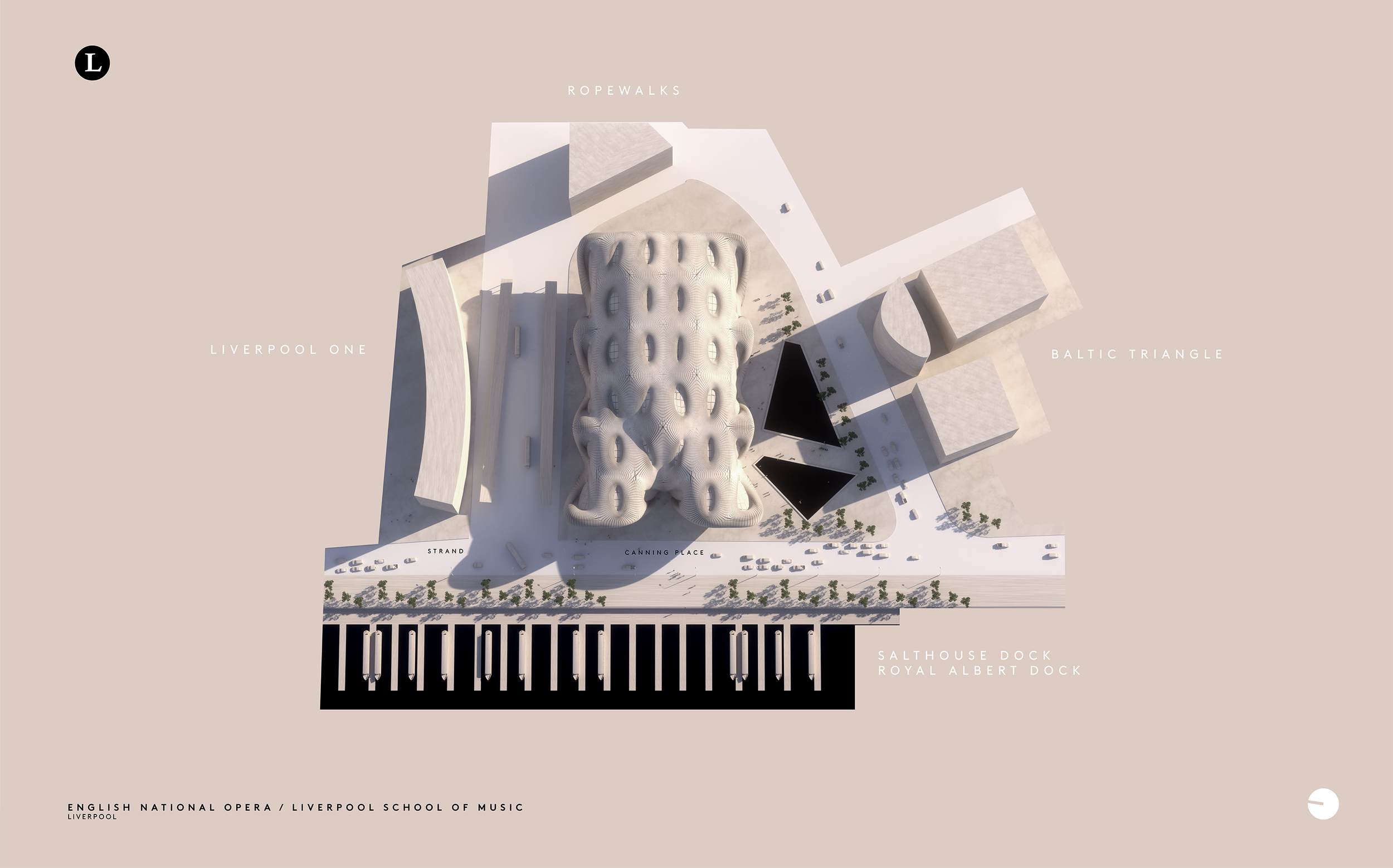
Liverpool Overhead Railway
Many people have long been fascinated by the Liverpool Overhead railway and perplexed by its loss. Extending seven miles along the length of the city’s impressive docklands from Seaforth and Litherland in the north to the Dingle in the south, the line survived for just 64 years before the decline in dock employment ate too deeply into its commuter base. There can be little doubt that if the Overhead Railway had survived into the modern era instead of being dismantled in 1956-57, it would have become another iconic symbol of Liverpool reminiscent of the Chicago ‘L’ trains. Not only that, but it may have long ago expedited the regeneration of the north docks into other uses. Instead, minus viable transport provision, we have had to watch on powerless as docks have lain derelict for decades under the tattered banner of Liverpool Waters.
As much as it’s fun to sit within an old Overhead carriage within the Liverpool Museum (and marvel at its spacious dimensions and varnished wooden interiors), Michael would much prefer to see it rebuilt. The case is becoming stronger with the soon to open Bramley Moore Dock Stadium, the Titanic Hotel and new apartments in the Tobacco warehouse extending the city centre and creating a line of activity to the attractions centred around the Albert Dock.
‘The Liverpool Overhead Railway may have long ago expedited the regeneration of the north docks into other uses. Instead, minus viable transport provision, we have had to watch on powerless as docks have lain derelict for decades under the tattered banner of Liverpool Waters.’
However, Michael says “we cannot and should not merely recreate a pastiche of the old line.” Technology and engineering have moved on, and the old structure was difficult and expensive to maintain. Besides, its heavy-set viaducts blocked views of the river from further inland, which might be unwelcome today. If the city are ever to rebuild the Liverpool Overhead Railway, he feels it should “celebrate the past but not be beholden to it.” A little like London’s Docklands Light Railway (DLR), his version 2.0 is a fully-fledged railway, not a monorail, elevated by organic and elegant concrete columns that avoid the blocky and very nineties form of the DLR design.
To maximise its utility, Michael’s new Liverpool Overhead Railway would not simply follow the old route but would connect more widely. Starting at Bootle in the north to better integrate that area as part of our metropolis, the line would connect the Everton stadium and key attractions centred around the Albert Dock before heading off south to the airport, and perhaps also east via the disused Waterloo or Victoria tunnels. The design of the structure would be modern, and the trains capable of running on conventional tracks (like the recently introduced Merseyrail ones) opening up options for integration with the wider rail network.
Royal Opera House North & Wirral Cultural Centre
At Liverpolitan, we’ve always believed the Wirral Waterfront to be Liverpool’s great missed opportunity. Overlooking one of the finest riverside vistas in the world, the left bank of the Mersey should be prime real estate, and yet it’s almost apologetically unimpressive – as if frightened to upstage its more famous brother. Surely, we can do better? “People laughed at the idea of Salford Quays hosting the BBC and the Imperial War Museum North,” says Michael, “but with its spectacular setting, the Wirral Waterfront should be aiming higher again.”
Two waterfronts, one city has to be the future but to really make that idea count, at some point we’ll need a significant intervention in the landscape. Wirral Council are doing good work in master planning a new Birkenhead with a better relationship to the river and Liverpolitan is all for it. But to seal the deal, argues Michael, “the Wirral needs something that stands out, something that can be seen from the Liverpool side – something that says ‘Look at me, come over to the Left Bank.’”
Given the 0.7 mile width of the Mersey between Liverpool and Birkenhead, any new landmark structure would need to be huge, gargantuan even. Taller than the 210 feet Ventilation Tower. Possibly taller than the 328 feet Radio City Tower. Cathedral-like in scale and presence. It was along those lines that McDonough put forward this earlier concept for a Royal Opera House North – aligned so that “you can see it as you look down Water Street – the two sides of the river visually connected with an iconic landmark; a catalyst for seeing Birkenhead through new eyes.”
The design is dominated by a series of steel funnels with a glinting chrome façade pointing in all directions of the compass including skyward. They would be wrapped around a central auditorium which could also have uses as a cultural centre exploring the Wirral’s fascinating history from the Vikings to its use as a monastic retreat, not to mention shipbuilding and its colourful background as a smugglers paradise.
‘The Wirral needs something that stands out, something that can be seen from the Liverpool side – that says ‘Look at me, come over to the Left Bank.’
Liverpool HS2
It’s all gone a bit quiet on the High Speed 2 railway project hasn’t it? Maybe that’s a good thing – just get on and build it. But for Liverpolitan, HS2 has always been something of a poker-tell, not so much about the lack of commitment of the national government to invest anywhere outside of the south – which to be honest, we can all take for granted. No, what HS2 really reveals in full technicolour is the shallowness of Northern solidarity – some places, most notably Manchester and Leeds are consistently favoured over others like Liverpool and Newcastle. Despite the sweet words of ‘King of the North’, Andy Burnham, arguments about agglomeration are forever used to draw money and opportunity towards these investment blackholes and away from everywhere else. And HS2 has been the smoking gun. More’s the pity that Liverpool’s own leaders have been too foolish to notice (or they never cared).
When the Conservative government announced the Integrated Rail Plan for the North and Midlands in late 2021, the media was full of a wailing and gnashing of teeth. Cutting HS2’s eastern leg to Leeds and scaling back plans for Northern Powerhouse Rail was seen as more evidence of the perfidiousness of London and Whitehall. Right on cue, Liverpool’s often hapless Metro Major Steve Rotheram, joined in the venting, complaining that “we were promised Grand Designs, but we’ve had to settle for 60 Minute Make Over.”
Not for the first time, a fair reflection of Liverpool’s own particular interests was absent, but with the help of railway campaigners like Martin Sloman and Andrew Morris of 20 Miles More, Liverpolitan spotted it. The truth was, the plan might have been less good for Leeds and Manchester but it was better for Liverpool. Fresh high speed track was going to be laid closer to the city in a dedicated spur that would relieve capacity constraints and increase the scope for an expansion in freight services. In addition, the need to widen the narrow throat entrance to Lime Street was also finally acknowledged. Hurrah!
‘What HS2 really reveals in full technicolour is the shallowness of Northern solidarity – some places, most notably Manchester and Leeds are consistently favoured over others like Liverpool and Newcastle.’
Still, wanting the best for Liverpool means building new track all the way into the city centre serviced by a full specification HS2 station. By the way, what happened to the commission set up by Steve Rotheram in March 2019 and announced with full fanfare at the MIPIM Property Exhibition, which chaired by Everton CEO Denise Barrett-Baxendale, was going to choose between 2 possible locations for a new “architecturally stunning” HS2 station in the city centre as well as 5 routes in for the track? Quietly dropped?
Focusing on the most likely outcome of a redeveloped Liverpool Lime Street, Michael has put together some outline designs, which incorporated the grade-II listed Radisson Red Hotel (previously the North Western Hotel) as the main entrance to the station.
To read Liverpolitan’s cutting dissection of HS2 and the Integrated Rail Plan for the North and Midlands, check out ‘HS2 – A Liverpool Coup?’ by Michael McDonough and Paul Bryan
Or to read Martin Sloman’s examination into the options for a city centre station, try ‘Lime Street or Bust? The Options For Liverpool’s HS2 Station’
Moorfields and the Commercial District
Back in March 2023, Liverpolitan tweeted about the state of Moorfields, which we described as “a regrettable symbol of Liverpool's down at heel CBD.” We noted that the area is littered with dereliction, empty office buildings and signs of homelessness, and asked the question, “Have we become so used to this embarrassing patch that we no longer see it as failure?”
The tweet received almost 45,000 views and provoked a whole host of online conversation with the issue later picked up by the Liverpool Echo. Councillor Nick Small, who after the recent local elections is now the city’s Cabinet Member For Growth and the Economy, got involved, agreeing that the site needs to be developed. There was some discussion about whether robust plans for the area were in place already as part of the City Centre Local Plan and Strategic Investment Frameworks (SIFs). But mostly, to the extent that the local BID or the Council have acknowledged the issue, action on the ground seems in short supply.
To some extent, the lack of regeneration may be an issue of plot owners sitting on parcels of land and waiting for a payday, but as a subsequent squabble between Merseyrail and the Council over who was responsible for cleaning the grotty Moorfields escalator showed, a lack of concerted coordination between agencies leaves ample scope for things to fall between the cracks.
Moorfields is littered with dereliction, empty office buildings and signs of homelessness. Have we become so used to this embarrassing patch that we no longer see it as failure?
Michael McDonough argues that Moorfields is another of Liverpool’s great missed opportunities and it’s hard to disagree. The area’s city centre location, great transport links, and historic setting within the traditional heart of Liverpool commerce, should with the right support, allow it to live again. “The whole area needs re-invention and the drift towards noisy bars and tourism serves to cheapen its prospects,” says Michael. He claims that demolishing the rotten Yates Wine Lodge should just be the start. “Moorfields can handle density and scale and is the perfect place to rebuild Liverpool’s grade-A office offer” centred around the idea of prestige and talent.
In these visuals, Michael wanted to rebuild the entrance to Moorfields Station with mid-rise commercial office space above – no more going up to go down. He also took a stab at upgrading the former Exchange Station offices, which “may have been grand from the front, but from the rear leave a lot to be desired” – failing to properly address the park that will hopefully one day be re-instated as part of new public realm within the wider Pall Mall development.
St Johns and Central Liverpool
Far, far and away McDonough’s biggest bugbear with Liverpool’s built environment has to the St Johns Shopping Centre. We know it’s commercially successful and last time we looked it had a 97% retail occupancy rate. It clearly fills an important niche within the city’s shopping offer with its cheaper rents for retailers. But damn if isn’t an ugly pig of a building (no offence to our porcine brethren). Arriving at Liverpool Lime Street, that’s the first thing you see. Talk about first impressions. Squatting over a network of old streets and the site of what would be today, if it hadn’t been bulldozed, a much valued Victorian market, Michael believes St Johns is a “dated lump of a building that acts as a physical and psychological barrier between London Road and the rest of the city centre.” It’s not a stretch to suggest that St Johns has played a role in the former’s decline. Repeated, half-hearted attempts to patch the shopping centre up have failed and its blue plastic blanket and struggling traders’ market are a testament to “a succession of bad planning decisions going back fifty plus years.” A lasting solution to all of these problems, says Michael, “requires demolition.”
The images Michael has put together here are a collection of different attempts to reinvent this “ugly and misfiring section of Liverpool.” The main driving force behind his designs is a desire to remove this “lumpen barrier” and re-stitch together our centre “in a more permeable way that evokes expressions of pride rather than cringes.” Michael wants to see a much better front door to Liverpool Lime Street – our city’s once grand hello and goodbye point. He’d like to replace this “parody of the city’s greatness” with something more iconic and ambitious.
‘St Johns is a dated lump of a building, its blue plastic blanket and struggling traders’ market a testament to a succession of bad planning decisions going back fifty plus years.’
The eagle-eyed might spot the use of neon and a prominent clock tower as a modernised callback to what the site has lost. As Michael says, “we can’t always recreate the past but we can be inspired by its best bits.” He’s also given the Grade 2-listed but still a bit ugly, Radio City Tower, a makeover, adding an elegant polished steel lattice of radiating lines which add height, fluidity and tricks of light to recast a regional landmark into one of world significance.
Read more about Michael McDonough’s vision for St Johns in the Liverpolitan feature, A New Central Liverpool.
The Silo
The former grain silo in the north docks is one of Liverpolitan’s favourite buildings in Liverpool. If it was just a little further south, closer to the Tobacco warehouse and Bramley Moore, we could imagine it being repurposed as a truly iconic, high capacity arts, events and business hub. However, the silo is located deep within the working part of the dock estate with industrial infrastructure all around it, so that idea is likely to remain a dream. Still, just imagine what could be done with this incredible structure. For McDonough, the project would “represent a development challenge similar to how London’s Bankside Power Station was transformed into the Tate Modern.”
For these visuals, Michael has re-imagined the space as a media industry hub – with film, TV and radio studios and education space for our universities – “a back-up plan in case the Littlewoods Film Project doesn’t deliver.” There would also be a theatre venue, gallery space and office facilities for the production sector – which he describes as “the perfect tonic to act as a catalyst for the regeneration of North Liverpool.” Another possible use, he suggests, might be a central hub for burgeoning logistics businesses if the new Freeport ever takes off. As you can see, Michael has taken the liberty of re-instating the Liverpool Overhead Railway, with ‘Silo Station’ ready to whisk visitors straight to the doorstep.
‘What Michael is attempting to do with these designs is to remind the city that it’s capable of bigger ideas, capable of re-imagining itself, capable of statement architecture, and capable of challenging its city rivals.’
Liverpool John Lennon Airport
Not for the first time, Liverpool John Lennon Airport finds itself in a strange position. Back in the years following World War 2, JLA (minus the Beatles moniker) lost its opportunity to become the north’s most important airport when the Ministry of Defence, which had requisitioned it for the RAF, sat on the asset while its Manchester rival grew. It’s been an uphill struggle ever since.
Not that Speke Airport, as some still call it, hasn’t had its days in the sun. For a time in the early 2000s, Liverpool was THE favoured location for budget airlines in the northwest as passenger numbers ballooned from 0.6 million in 1997 to 5.5 million in 2007. That growth stalled as its much larger rival came to its senses and stopped turning its nose up at budget travellers. Still, JLA has remained a valuable strategic asset for the city, and despite the devastating blow that Covid dealt to its passenger numbers and its finances, the airport is making a solid recovery. Finally free of the dominant stranglehold of Ryanair and Easyjet, the airport is now diversifying its offer, attracting new airlines such as Lufthansa, Air Lingus and Wizz Air. And JLA continues to pick up a steady stream of awards for the efficiency of its operations, where queues tend to be largely absent.
Sad then, that Liverpool Airport has found itself consistently under attack in recent years from local environmental activists such as Liverpool Friends of the Earth and the Save Oglet Shore campaign group, who appear to want to make an example of it, by opposing all possible expansion. In fact, it’s been pretty clear in Liverpolitan’s own Twitter debates with these groups that there are those who would like to see the airport closed altogether – its miniscule contribution to the nation’s CO2 output too much for some. Others claim the farmers’ fields to the south are too ecologically important to lose or that air quality is impacting the health of local residents – the result in part of some very strange and short-sighted choices by the Planning Department on where to locate new residential developments. Inexplicably, our council continues to have a very ambivalent attitude to what should rightly be viewed as a key enabler of our economic prosperity.
‘The reality is, the healthy human desire to travel and see the world will not and should not be legislated away by those with a dystopian vision of the future.’
The reality is, the healthy human desire to travel and see the world will not and should not be legislated away by those with a dystopian vision of the future. The technical challenges to realising a cleaner way to fly are immense, but they are not uniquely Liverpool’s burden and no other city would so blindly hobble itself in restriction.
Michael McDonough grew up next to Liverpool John Lennon Airport and has seen its infrastructure grow from “a small, bland, industrial shed of a terminal into something more befitting,” and at some point in the future he believes it will need to expand. Michael argues that better public transport provision should be a priority with an extension of the Northern line or a tram connection mooted as alternatives. In these designs, Michael has proposed a train line that tracks underground for the final few hundred meters to arrive directly at a much expanded terminal. The capacity of the current structure is around 7 million, so if JLA can hold onto its post-Covid gains and continue to build upon them, discussions about what comes next will be inevitable. “The myopic few who claim the northwest already has a large airport and doesn’t need another, are shutting their eyes on the obvious.,” says Michael. “Demand for flying will continue to rise and the north can easily sustain a larger Liverpool John Lennon Airport at Speke.”
Northern Assembly
Given the shenanigans at Liverpool City Council in recent years, it might seem strange to suggest our city as the seat of political governance for the whole of the north. But a Labour government is a distinct possibility come 2025 and they’ve often flirted with the idea of greater regional devolution and a northern assembly to govern our unruly mob. Manchester is the usual default option, of course, but at Liverpolitan we can’t be having that. Perhaps only Newcastle can offer the grandeur of our riverside estuary setting here on the Mersey. Wouldn’t it be wonderful if Liverpool took inspiration from its darkest days to become a paragon of democratic values? To take accountability and citizen engagement as its governing principle, to put behind it the days of boss politics and party before city, and instead show the world how local government is done when at its best.
McDonough’s design of a new Assembly district is based on a wholly different concept to Peel’s current underwhelming plans for Liverpool’s central docks – albeit quite capable of incorporating a sizeable, new park. The site encompasses a parliament building, ancillary office space, a new cultural centre with notes of modern gothic and an extension of a revitalised mixed-use Ten Streets area including substantial residential to repopulate the area and give it life. In these days when the potential for terrorist attacks is sadly a design factor, Michael believes the location’s riverside setting has unique advantages, making it defensible for security services. Addressing concerns about the loss of ‘blue space’ at Waterloo Dock, he has increased the provision of waterways by reclaiming some of the infilled land, and bridging buildings across it. This Michael explains is “meant as both a symbolic and practical gesture of compromise in a city often at loggerheads with itself on how to reach for the stars architecturally without compromising existing heritage elements.”
Naturally, this substantial expansion of our city centre, requires transport infrastructure, which Michael has designed in with a new station at Vauxhall on the Northern line. Such investments in transport become more viable as we add additional all-year-round uses instead of just relying on the footfall that the new Bramley Moore stadium will provide.
‘Wouldn’t it be wonderful if Liverpool took inspiration from its darkest days to become a paragon of democratic values? To put behind it the days of boss politics and party before city, and instead show the world how local government is done at its best.’
For a fuller exploration of this concept, read Michael McDonough’s Liverpolitan feature, Welcome to the Assembly District.
Liverpool Central Station
The redevelopment of Liverpool Central Station has long been on Merseytravel’s wish list and it’s not hard to understand why. Boasting the highest passenger numbers of any underground station in the UK outside of London, Liverpool Central is, despite recent minor refurbishment, “a dark, dated and cramped station prone to over-crowding,” according to Michael. Its current single island platform structure and track layout on the Northern Line section also places restrictions on train capacity. A full scale expansion of the station, which the Liverpool Combined Authority are pushing central government for, would allow more trains to run through services linking up the Northern and City lines via a re-used Wapping Tunnel. This would in turn free up capacity at Lime Street Station enabling it to focus on its role as an intercity and regional transport hub.
A few years ago there were grand plans to convert the old Lewis’ department store which sits next to Central Station into a new shopping centre accommodating new residential blocks. A side benefit of the scheme was the use of Lewis’ ground floor to open up a new, additional entrance to the station itself. However, the proposed scheme, which ultimately came to nothing, left intact the tired, almost prefab current station entrance – “a pale shadow of what was once a magnificent Victorian railway terminal,” says Michael.
McDonough believes that when the time comes to rebuild this thing, we should “go all out and design a station that lets in the light.” These visuals imagine a doubling in the size of the station envelope, with an additional platform, and the complete removal and replacement of the shopping arcade with a dedicated railway concourse at the street level front end. The plan would allow the floor above the underground platforms to be removed allowing sunlight to reach down to create a much more welcoming environment. Reinforced as a major local transport hub for the city, and with the poorly performing shopping centre now gone, Michael believes the wider site offers potential to “accommodate new office and residential accommodation at impressive scale.”
‘The proposed scheme, which ultimately came to nothing, left intact the tired, almost prefab current station entrance – a pale shadow of what was once a magnificent Victorian railway terminal.’
New Brighton Pier and Observation Tower
The advent of foreign travel certainly did for many of Britain’s seaside resorts. Still, nostalgia aside, glancing through old photographs of New Brighton does makes the heart bleed for what was lost. It’s hard to think of a more striking example of the region’s self-destructive attitude towards its built environment than the loss of the old ballroom and tower, fire or no fire. Not to mention its pier, pleasure grounds and lido. Daniel Davies of Rockpoint Leisure has been doing his bit in recent years to bring a bit of hip to Victoria Street and the Championship Adventure Golf course is well worth a visit too. In fact, there are tentative signs that Wirral Council are starting to understand what they have, even if the area has been stripped of many of its key attractions. Liverpool’s Left Bank can and should be a treasured beauty spot, a place for families to enjoy and a haven for the avante garde and edgy. Now is the time to think bigger.
Michael hasn’t yet worked on a full plan for New Brighton but bringing back some kind of landmark beacon with a viewing deck, visible from the other side of the Mersey and prominent to the passing cruise ships feels like it should be part of the picture. Back in the early 2000s, sculptor Tom Murphy proposed a 150-foot statue of the Roman god, Neptune, to sit in the waters at the mouth of our mighty river – Liverpool’s equivalent of the Statue of Liberty or the Colossus of Rhodes. Oh, how we’d like to have seen that! Or if money was no object, two of them either side of the river standing proud like the Argonaths of Lord of the Rings. In the meantime, Michael McDonough took a stab at a slightly less monumentalist beacon a few years ago.
‘Back in the early 2000s, sculptor Tom Murphy proposed a 150-foot statue of the Roman god, Neptune, to sit in the waters at the mouth of our mighty river – Liverpool’s equivalent of the Statue of Liberty or the Colossus of Rhodes.’
The Liverpool ‘Angel’ Bridge
Unashamedly a flight of fancy and almost certainly the most outlandish of McDonough’s ideas, the concept of a bridge linking Liverpool and Birkenhead delivers an element of San Francisco’s Golden Gate magic and then tries to one-up it. There’s something slightly Game of Thrones about this design, which Michael says he wasn’t consciously thinking about at the time. “It’s intended as statement architecture,” says McDonough, “A big ‘Here I am’ to the world that would forever add a new image to the iconography by which Liverpool is known.” The idea behind it is to unlock the two sides of the Mersey as one urban centre, transforming Birkenhead’s prospects for the better. It would, of course, be ludicrously expensive and so is likely to remain one for the mind’s eye. “Building this kind of structure would take serious doses of civic ambition and that’s the kind of vision we don’t often see in these parts,” said Michael.
For those worrying whether the bridge would undermine the Mersey tunnels, it has been designed as pedestrian-only, although it could be adapted to accommodate light rail or electric tram-buses. In terms of location, on the Liverpool side, Michael imagines it would sit between the Albert Dock and the Museum of Liverpool, while over at Birkenhead, the bridge would land at Woodside, right next to his alternate proposed site for an Opera House North.
“It’s intended as statement architecture”, says McDonough, “A big ‘Here I am’ to the world that would forever add a new image to the iconography by which Liverpool is known.”
…and finally.
Project vision and designs by Michael McDonough. Article by Paul Bryan.
Paul Bryan is the Editor and Co-Founder of Liverpolitan. He is also a freelance content writer, script editor, communications strategist and creative coach.
Michael McDonough is the Art Director and Co-Founder of Liverpolitan. He is also a lead creative specialising in 3D and animation, film and conceptual spatial design.
Share this article
What do you think? Let us know.
Write a letter for our Short Reads section, join the debate via Twitter or Facebook or just drop us a line at team@liverpolitan.co.uk
Referendum or bust – Liverpool’s last chance?
A discredited administration hamstrung by scandal. A weakened leader eyed by pretenders to the throne. A collapse of trust. And, underlying it all, a sense of drift and a loss of status in the world. For Boris Johnson’s Britain read Joanne Anderson's Liverpool. Both increasingly tottering on the precipice.
Liam Fogarty
A discredited administration hamstrung by scandal. A weakened leader eyed by pretenders to the throne. A collapse of trust. And, underlying it all, a sense of drift and a loss of status in the world. For Boris Johnson’s Britain read Joanne Anderson's Liverpool. Both increasingly tottering on the precipice.
Of course, it would be unfair to blame the city's current Mayor for more than a fraction of the woes afflicting Liverpool and its council. But her discarded pledge of a referendum to decide on whether to keep Liverpool's mayoral system was more than just another politician's broken promise. It was an affront to local democracy. The pitifully small response to the council’s subsequent governance consultation – just 3.5% of Liverpool residents replied - was inevitable. Launched in March, and conducted almost entirely online, the process was an artist's impression of a democratic exercise. The letter sent to each city household, directing its recipients to the Liverpool – Our Way Forward website, looked and read like a tax demand. Residents had 3 months to reply but a council taxpayer-funded "Have Your Say" supplement to promote the consultation was published with the Liverpool Echo on June 10th a mere ten days before the submission deadline. Perhaps if they were going to be this half-hearted they shouldn’t have even bothered. Its four vacuous pages contained plenty of room in which to set out the arguments for and against the various governance models on offer. Incredibly, it did not do so. An opportunity for meaningful engagement with Echo readers was spurned in what became a literal waste of space.
So what is to be done?
In his ground-breaking mayoral election campaign last year, as Liverpool absorbed the findings of the Caller Report into council misconduct, Independent candidate and eventual runner-up, Stephen Yip, called for a "re-set" of Liverpool City Council. He demanded top-to-bottom reforms in response to Caller's damning discoveries. The re-set phrase proved popular and was soon taken up by Labour's candidate, Joanne Anderson during her campaign. Once elected, however, she abandoned her commitment to resolve the mayoralty issue by means of a public vote, claiming a consultation would cost less than a full referendum which she deemed too expensive to justify. Since Joanne’s election, we have seen backsliding on the promises of more transparency and scrutiny of council business. Caller’s recommendation for a significant reduction in the number of councillors has been ignored, with the current 90 councillors being reduced merely to 85. Meanwhile, government-appointed commissioners now report that in several respects our council is going “backwards not forwards” in dealing with the issues it faces.
The loss of millions of pounds thanks to a botched energy contract showed systemic failings were not confined to the departments excoriated by Max Caller. There’s talk of more commissioners being drafted in, and more departments falling under their iron fist as skeletons continue to tumble out of closets. Not so much a re-set, then, as a return to politics as usual in Liverpool.
Stephen Yip and I agree that the first step towards an actual re-set is to let the people of Liverpool decide how their city should be led. Liverpool is local democracy’s ‘black hole,’ the only major city in England to have repeatedly denied its residents the chance to vote on how it should be run. The idea that Liverpool's citizens should be able to decide whether to keep or scrap the mayoral system is anathema to the control freaks at the Town Hall. Our politicians won't give us the mayoral referendum we are entitled to unless they are forced to.
Former Independent Mayoral Candidates, Liam Fogarty and Stephen Yip, launch ReSet Liverpool, a campaign to force Liverpool City Council to run a full referendum on city governance.
ReSet Liverpool
That’s why we are launching ReSet Liverpool, a petition-led campaign to give the people of the city the referendum they were promised. We reject the council's attempt to take such a huge decision on the city’s governance by itself. Options for the future running of Liverpool should be put directly to its residents at the ballot box.
Our petition aims to secure the 16,500 signatures (5% of the city's electorate) needed to trigger a referendum on whether Liverpool should retain the post of directly elected Mayor. A referendum held next May to coincide with scheduled elections for a Mayor and local councillors would come at minimal additional cost.
The final say on this issue should belong to the people, not politicians. It’s a matter of principle. Self-serving attempts to sideline the electorate are destructive. They weaken the already-strained connection between the people of Liverpool and their local council and lead to greater cynicism and indifference.
“The final say on this issue should belong to the people, not politicians. Options for the future running of Liverpool should be put directly to its residents at the ballot box.”
Without a referendum, Liverpool’s politicians are likely to revert to type. If they do move to abolish the mayoralty without public consent, then the simmering – and largely unreported - power struggles inside the council’s majority Labour group will burst open, absorbing the time and energies of all those involved. Mayor or no Mayor, in May 2023 every Liverpool council seat will be up for grabs on new electoral boundaries. As what is now 30 wards morphs into a whopping 70 smaller ones, once safe council positions will be under threat as councillors from the same party will be forced to compete with each other. The jockeying to be selected as candidates has already started and local parties’ fratricidal tendencies will be given full rein. The ward elections themselves will provide ideal conditions for the kind of hyper-local political warfare that appeals to party activists but no-one else. The chances of such a process producing a clear city vision, strong civic leadership and a coherent policy platform will be remote. Not for the first time, Liverpool politics will be all tactics and no strategy.
For ReSet Liverpool, a referendum on the mayoralty is the very least the people of this city deserve. May be it can also be the start of a broader campaign to reform our council and renew our city. If you are registered to vote in Liverpool, download a petition form (HERE) and if they live in Liverpool, get your friends, family and neighbours to sign up. Together, we have a chance to help kick-start that overdue process of civic renewal. It could be the last chance we’ll get.
Liam Fogarty is co-founder of ReSet Liverpool. A journalist, broadcaster and lecturer, he ran as an independent in Liverpool’s first Mayoral Election in 2012, finishing second.
Further Information
To find out more about Reset Liverpool and to download a copy of the petition, visit www.resetliverpool.org. Note: Only Liverpool residents over the age of 18 who are registered to vote can sign the petition. Completed petition forms should be returned to:
Reset Liverpool
301 Tea Factory
Fleet Street
Liverpool
L1 4DQ
Share this article
What do you think? Let us know.
Write a letter for our Short Reads section, join the debate via Twitter or Facebook or just drop us a line at team@liverpolitan.co.uk
The Beatles: Inspiration or dead weight?
When does city pride in the Fab Four turn into a hindrance to future achievement? Jon Egan argues that the city of Liverpool is in danger of becoming a Beatles theme park, and its world conquering band a crutch to exorcise the painful intimations of our diminished relevance and prestige. In looking to the past, have we forgotten what made John, Paul, George and Ringo so special - their fearless embrace of the avant-garde, the contemporary and the new?
Jon Egan
There was something profoundly true and desperately sad in University of Liverpool lecturer, Dr David Jeffery's acerbic observation that "Liverpool is a Beatles' shrine with a city attached."
It is the dispiriting obverse to music journalist, Paul Morley's rhapsodic description of Liverpool as "a provincial city plus hinterland with associated metaphysical space as defined by dramatic moments in history, emotional occasions and general restlessness."
Jeffery's comments on Twitter appear to have been inspired or provoked by the recent announcement that Liverpool would be using a £2 million grant from Government to advance the business case for yet another "world-class" and "cutting-edge" Beatles' attraction on our hallowed waterfront. Presumably, it will be sandwiched somewhere between the Beatles statue and The Beatles Experience and conveniently close to The Museum of Liverpool and The British Music Experience with their not inconsiderable collections of Beatles artifacts and memorabilia. The exact nature of this new cultural icon remains a little unclear, however, amidst wildly differing descriptions offered by our City and Metro Mayors.
What is deeply depressing about this announcement is that it suggests that Liverpool is incapable of imagining any kind of cultural proposition that is not predicated on the seemingly inexhaustible allure of the four boys who shook the world.
There is of course a readily available and seemingly plausible justification for the never-ending Beatles' fetish, and that is the claim that they are the anchor for our hugely important tourism economy. Notwithstanding the implication that David Jeffery is right to suspect that the city is consciously morphing into a Fab Four theme park, I suspect that this is not exactly the whole truth. For Liverpool, The Beatles are a crutch, a cherished emblem of identity and importance used to exorcise painful intimations of diminished relevance and prestige.
In the novel, Immortality, Czech writer Milan Kundera tells the story of the man who fell over in the street, who on his way home stumbles on an uneven pavement, falls to the ground and arises dazed, grazed and dishevelled, but after a few moments composes himself, and gets on with his life. But unbeknown to the man, a world famous photographer happens to witness the scene and quickly snaps an image of the bewildered and bloodied pedestrian. He subsequently decides to make this picture the cover image for his new book and the poster for his international exhibition. For the man, a momentary misfortune freeze-framed, replicated and disseminated across the world, becomes the image that will forever define who he is.
The more we conflate the Beatles brand with the city's identity, the less space we have to imagine anything original, contemporary or remarkable.
In a sense, Liverpool is the City that fell over on the street, our external image is in significant part, defined by a succession of misfortunes, afflictions and tragedies that befell the city over two decades at the end of the last century. These events forged images, preconceptions and stereotypes that still blight us today and have never been successfully exorcised or replaced.
The Beatles hark back to a time before this blight, when Liverpool was in Alan Ginsberg's celebrated phrase, "the centre of consciousness of the human universe." They are, I believe, a therapeutic distraction from the task of making a different story or discovering a new identity.
Culturally, our Beatles fixation is unhealthy, debilitating and regressive. In fact, I fear we are reaching a point where The Beatles will become the single biggest impediment to any form of civic progression, or any serious project to make Liverpool important, interesting or relevant in today's world. If we are going to have a civic conversation about what kind of "world class" Beatles attraction should be erected at The Pier Head, my immediate impulse would be to recommend a mausoleum.
But perhaps a more imaginative and original idea was the one offered by the late Tony Wilson. That supreme Mancophile, Factory Records producer, Granada TV reporter and founder of the Hacienda nightclub was never held in particularly high regard in this city, especially following some tongue in cheek words of encouragement he gave to Club Brugge on the eve of their European Cup semi-final with Liverpool in 1977. Scousers may resemble elephants with respect to their prodigious powers of memory, but our skins can sometimes be just a tiny bit thinner. Tragically, Wilson's Mancunian persona and his tendency to lapse into casual profanity whilst presenting his project to civic decision-makers proved the undoing of his brilliant and visionary proposition for POP - the International Museum of Popular Culture. Pitched as the big idea for the European Capital of Culture, and the solution that would provide content for Will Alsop's audacious but otherwise functionless Fourth Grace, POP was a talisman for instant reinvention - a Beatles-inspired attraction without any reference to The Beatles. Alas it never happened.
Wilson had first dreamt of POP as an adornment for his own native city and a fitting celebration of its notable contribution to the history of modern popular music, but he soon realised that it was the right idea for the wrong place. He would often express irritation that when travelling in the US he would frequently have to explain where Manchester was by reference to its proximity to Liverpool - a place that people had actually heard of. And there was also the grudging recognition that at a time when Liverpool was "the centre of the human universe" globalising popular culture - Manchester could only offer us Freddy and The Dreamers. Even the outrageous charisma of Manchester United football god, George Best was derivative as he was often dubbed the 5th Beatle.
POP would not simply have been about popular music, it would encompass every facet of popular culture, every expression of contemporary creativity in film, TV, advertising, games, cars, sport, fashion, digital technology and consumer culture. And it was proposed for Liverpool because this was the place that spawned a phenomenon that reached the four corners of the Earth. It was a moment when the world discovered a common currency and a cultural vernacular intelligible to every ear.
POPs content would be dynamic and ever-changing, a continuous exposition of the new, curated by global creatives, designers and technologists. It would be Liverpool recovering its world city perspective and its capacity to invent and innovate - the pool of life, the birth canal for the extraordinary and the unprecedented. Its ingenious paradox was its implicit assertion that The Beatles did not make Liverpool, but Liverpool made The Beatles.
They monopolise our self-image occluding facets of identity and history now only half-glimpsed in the penumbra of a shadowy scouse dreamtime.
All of which is a million miles from Steve Rotheram's "world-class immersive experience" which he promises us will be more spectacular than a glass cabinet containing John Lennon's underpants. We can hardly wait.
If all we can possibly imagine are The Beatles etherealised into holograms - almost literally spectres from beyond the grave - then David Jeffery is right and Liverpool's once rich and cosmopolitan culture has collapsed into a black hole of redundant clichés. The more we inflate our Beatles offer and conflate their brand with the city's very identity, the less space we have in which to imagine anything original, contemporary or remarkable. Along with football (which at least tells new stories) they have come to monopolise both our external brand and our officially curated self-image, occluding facets of our identity and history that are now forgotten and suppressed, only half-glimpsed in the penumbra of a shadowy scouse dreamtime.
The Beatles have come not only to represent our brand, but have also helped to define our personality, attitude and accent - cheeky, chippy, sassy and defiant. As emblems of the 60s social revolution, they helped to forge and reify the idea of Liverpool as a working class city - or more accurately an exclusively working class city. As rock journalist Paul duNoyer, notes in his book, Wondrous Place, this is both a false and profoundly disabling imposition. Not only, as Tony Wilson asserted, are we the city that globalised popular culture, but we are a city that has contributed massively to every facet of culture, ideas and invention over the last 200 years.
The world's first enclosed dock and inter-city railway, together with the completion of the Transatlantic telegraph cable, are not only stunning achievements in technological innovation, but bolster the credible claim that globalisation began here.
The extent to which we have been willing to squander or disown the breadth of our cultural heritage was brought home to me in the febrile final stages of the European Capital of Culture bidding competition. Having commissioned pop artist, Sir Peter Blake to create a homage to his iconic Sgt Pepper album cover to remind the world, or at least the judging panel, of Liverpool's cultural and intellectual prowess, the task of deciding who exactly was worthy of inclusion was both fraught and enormously revealing. Apart from a few contemporary, and at the time highly topical creatives including the poet Paul Farley, artist Fiona Banner and film-maker Alex Cox, the principal criterion for inclusion appeared to be the directness or intimacy of connection to The Beatles. A lop-sided bias towards musicians, popular entertainers and Sixties icons meant no room for the likes of painters George Stubbs and Augustus John, poets Nathaniel Hawthorne and Wilfred Owen, novelist Nicholas Monsarrat, playwright, Peter Shaffer or even poet and novelist, Malcolm Lowry the author of the celebrated, Under the Volcano. Incredibly, until Bluecoat Artistic Director, Bryan Biggs' finally succeeded in persuading Wirral Council to erect a blue plaque on New Brighton's sea wall, there was virtually no public recognition that one of the 20th century's greatest and most influential novelists had any association with the Liverpool City Region.
Without questioning or diminishing the impact of the Mersey Sound poets (McGough, Henri and Patten) in the 1960s, their literary status is no way comparable to another unsung and forgotten cultural luminary with a significant Liverpool connection - C.P. Cavafy. Now acknowledged as one of the last century's most important and original poetic voices, Cavafy spent much of his childhood at addresses in Toxteth and Fairfield. Greek and gay, his poetry will forever be associated with the city of Alexandria where his family settled after leaving Liverpool. We do not know to what extent his formative years in the city helped nurture Cavafy's creative animus, but transience, up-rootedness and departure are woven into our narrative. Our sense of self and place in the world as Liverpolitans, owe as much to those who moved on, or merely passed through, as they do to those who stayed or settled here.
We are not, and never have been a monochrome canvass or a one trick city. Our culture is dense, deep and multifarious, formed by a hotchpotch of races, creeds and classes. For those tasked with defining a place and communicating its uniqueness to the world, there is always the temptation to reduce and simplify.
Brands, including place brands, are often conceived like Platonic forms - a distilled essence, fixed and immutable. But cities like Liverpool are neither simple nor static, and are thus frustratingly un-brandable. Described by Wilson as a place with "an innate preference for the abstract and the chaotic," our essence is pre-Socratic - unresolved, unpredictable and disconcerting. We know that port cities like Liverpool, Naples, Barcelona and Marseilles have historically been melting pots for ideas, influences and cultures - places where things never quite settled.
But their edginess is not merely a function of a perturbed diversity, it is also literal. It's connected to Marshall McLuhan's philosophical idea of right hemisphere sensitivity and the expanded perspective of what he terms acoustic space. Ports face outwards, they are perched on the precipice of a vast and formless abyss. It's an omnipresent reminder that there are no limits.
For Paul Morley, Liverpool’s character and identity - its ability to charm, entertain, inspire and infuriate - proceed from an inchoate restlessness and fidgety creativity. It's a place "where something happens, most of the time, leading to something else." But it seems like that creative energy and inventiveness have deserted us - or at least our leaders. What was once an animating pulse has been reduced to a piece of hollow rhetoric - a brand attribute.
It's sad that a UNESCO City of Music should have forsaken polyphony, and that we are continually stuck in a repetitive groove, narrowing our identity and stifling our capacity to be original (again). For this reason the very last thing Liverpool needs is yet another Beatles' attraction, even an immersive one.
So, OK, The Beatles were important, are important. They changed the world, but did they change Liverpool? We're still, I hope, the city capable of creating something else.
Jon Egan is a former electoral strategist for the Labour Party and has worked as a public affairs and policy consultant in Liverpool for over 30 years. He helped design the communication strategy for Liverpool’s Capital of Culture bid and advised the city on its post-2008 marketing strategy. He is an associate researcher with think tank, ResPublica.
Share this article
Life after Joe: Ditching the Mayor won’t fix our broken democracy
There’s something nearly all of Liverpool’s political parties agree on - the need to abolish the office of directly elected city mayor. But are their positions based on principle, self-interest or just faulty logic? In 2022, the public should get to decide the question for itself in a referendum, but with such a one-sided campaign in prospect, there’s an acute danger that we’ll sleep walk into this vote without the chance of a properly informed debate.
Jon Egan
When nearly all of Liverpool’s political parties agree on something, you can bet it’s on an issue of mutual self-interest rather than in defence of any cherished principle.
As things stand, Liverpool’s voters will be invited, most likely in 2022, to decide whether to keep or dispense with the office of directly elected city mayor. It promises to be a rather one-sided campaign with the city’s three largest political groups (Labour, Liberal Democrats and Greens) all arguing for abolishing the post and returning to what they collectively describe as the “more accountable” Leader with Cabinet structure.
Even our recently elected incumbent, Mayor Joanne Anderson, is pledging to vote for the abolition of her own job, which begs the question, why she was so anxious to run for office in the first place? But of course, she was not alone. In the 2021 mayoral election, only two candidates - the Independent, Stephen Yip, and the Liberal Party's Steve Radford - were actually standing on a pro-mayor ticket. Indeed, following the unprecedented intervention by Labour's ruling National Executive to disqualify all three of the senior councillors on the original selection shortlist, both the Labour and Liberal Democrat council groups attempted to cancel the election by abolishing the role without recourse to a public referendum, until they were stopped in their tracks by polite reminders from their own legal officers that such a move would be unlawful.
There is an acute danger that we will sleep walk into this referendum without either a campaign or a properly informed debate. Voters will be asked to reflect on the need to learn lessons from euphemistically labelled "recent events" and fed the seemingly plausible line that one mayor is better than two. After all, why do we need a city mayor now that we have a metro mayor?
Of course, there is a shadow hanging over this whole discussion – one powerful argument for the case against elected mayors – which comes in the shape of the now under investigation and widely discredited former mayor, Joe Anderson. For some, he has become a walking metaphor and deal-sealing symbol of the dangers of too much power in the hands of one larger than life individual. But this is too important a decision for knee-jerk reactions. Our democracy demands that the subject be properly examined and debated. It’s too easy for us to be seduced by over-simplified and questionable arguments. We should think hard before dispensing with a model, that I would contend, has never been properly embraced or tried by our local politicians.
There is an acute danger that we will sleep walk into this referendum without either a campaign or a properly informed debate.
Before we head off to the ballot box (presuming we get the chance), there are some key questions we have to consider. Are mayors generally a good thing? Can they achieve results that old-style council leaders can't? Is there something specifically about Liverpool and the state of our local governance, our politics and our economic and social predicament that makes having a city mayor here particularly desirable or dangerous? And how are we to make sense of our experience of the mayoral model to date? Are the critics right that the concentration of power has been unhealthy or even corrupting?
But first… a little context. Let’s delve back into the city’s recent history to find out how we ended up in this mess. City mayors were an early prescription for what is now fashionably described as ‘levelling-up.’ The problem of a seriously unbalanced economy and underperforming urban centres was a matter of serious priority for the incoming New Labour government in 1997. The publication of Towards an Urban Renaissance - the report of Lord Rogers' Urban Task Force was a seminal moment in re-prioritising the importance of cities as vital engines for growth, innovation and national prosperity.
We’ve been here before - Liverpool’s democratic deficit
Harnessing that growth, it was implied, would require a new kind of energised civic governance similar in form and style to the dynamic leadership that had successfully regenerated European and North American cities such as Barcelona and Boston. In contrast, the fragmented committee structure of local government, then dominant in the UK, was seen as a recipe for old-school inefficiency and a failure of imagination. A new Local Government Bill (2000) set out the options to reset civic democracy. There was no coercion; just three choices: Leader and Cabinet (close enough to stay as you are), and two flavours of the big bang option for directly-elected City Mayors. Towns and cities were free to decide for themselves and unsurprisingly, councils overwhelmingly chose the least change option with only a handful willing to embrace the more radical mayoral restructure.
In Liverpool, however, the idea of a directly elected mayor aroused immediate interest, though admittedly not amongst our politicians. Instead, the city's three universities, its two largest media organisations (BBC Radio Merseyside and the Liverpool Echo) and a collection of faith leaders convened the ground-breaking Liverpool Democracy Commission in 1999. Under the chairmanship of Littlewood's supremo, James Ross, the independent commission brought together politicians, academics, and community and business leaders such as Lord David Alton, Professor of Urban Affairs, Michael Parkinson (now of the Heseltine Institute), radio presenter Roger Phillips, and Claire Dove, a key player in the local social enterprise movement. They took evidence from national and local experts and were shadowed by a Citizen's Jury to widen representation. In turn, the city council made a commitment to consider its recommendations and, if a mayoral model was advocated, to hold a public referendum.
From its inception it was clear that the commission was not simply evaluating the general merits of the available models, but was considering their applicability to Liverpool’s very particular local circumstances. Those circumstances included a wretched turnout of just 6.3% when a tired and divided Labour administration lost its majority in the crucial Melrose ward council by-election in 1997, the lowest ever poll in British electoral history. A Peer Review of the troubled council at the time by the Independent and Improvement Agency had painted a picture of lethargy, cronyism, an insular town hall culture, and wretchedly poor service delivery. Liverpool was acutely aware that its civic governance required a radical reboot.
Leaders run councils, Mayors run cities
The more general case for a directly elected mayor centred on its ability to reinvigorate local democracy, transferring the focus of civic leadership from the inner minutiae and manoeuvrings of the town hall to the wider city – its communities, businesses and institutions. As local government academic Professor Gerry Stoker put it when giving evidence to the Democracy Commission, “Leaders run councils, mayors govern cities.”
Stoker was by no means alone in advocating this radical change. Evidence from witnesses, community meetings, public surveys and the Citizen’s Jury converged on the same transformational proposition. Mayors could be convenors, able to galvanise civic energy by bringing multiple parties together in partnership. They would change the destiny of places in ways that our stilted and bureaucratic town halls could never hope to emulate.
Against this backdrop, the idea of giving every citizen the opportunity to vote for the city's leader seemed refreshingly progressive. It also offered a tantalising possibility - a radical break with party politics. Theoretically, the elected mayor system provides a level playing field for independent candidates. No longer would political parties with the networks and infrastructure required to support candidates in all of the city's wards be able to monopolise the system. Politics could be open, unpredictable and much more interesting and the talent pool from which to select a city leader was immediately expanded. Clever and experienced people from business and civil society would step forward to offer themselves for election.
But above all, it was the radical simplicity of the democratic contract that commended the mayoral model. No longer would local democracy be transacted behind closed doors, shrouded by arcane traditions and enacted through the inscrutable election-by-thirds voting system that somehow allowed political parties to lose elections but miraculously stay in power. With a directly-elected mayor, there would be visible leadership, clear and simple accountability and a transparent means of returning them or removing them from office.
By blaming the mayoral model for the shameful abuses and failures identified by Caller, our councillors are indulging in a transparently hollow attempt at self-exoneration.
It was for that reason that elected mayors were pitched as the antidote to voter disaffection, not just in Liverpool but across the whole country. Turnouts for local elections were in decline everywhere resulting in a widely acknowledged crisis of legitimacy.
Legitimate or not, one year before the Democracy Commission was founded, Liverpool’s voters had their say, overcoming their most ingrained cultural instincts to throw out what they knew was rotten. Liverpool's Labour administration was swept from power by an almost entirely unpredicted Liberal Democrat landslide.
So it would be a Liberal Democrat administration that would decide whether to adopt the mayoral model and respond to the unequivocal recommendation of The Democracy Commission. But they fluffed their lines, embracing instead the less radical option offered by the New Labour government – a Leader with Cabinet. Not for the first time, our political leaders knew best. Rather than allowing voters to choose their preferred model via the referendum they had promised, the council opted for the one that suited their own ends best.
Paradoxically, Liberal Democrat Council Leader, Mike Storey’s style and swagger were almost mayoral. He set up the UKs first Urban Regeneration Company (Liverpool Vision) and boldly calibrated a vision of the city as a European Capital of Culture. These were heady days, and many will now look back nostalgically on Storey’s early tenure as a time of almost limitless promise. So what went wrong?
Storey was instinctively attracted to the idea of city mayors and thought he could be one without having to navigate this dangerously Blairite and centralising heresy through his notoriously individualistic and anarchic Liberal Democrat Party. But Storey was constrained both by the instincts, prejudices and personal ambitions of his own political group, but perhaps more importantly, by the absence of an independent democratic mandate. His leadership rested on the confidence and acquiescence of his unruly Lib Dem caucus, but also on the compliance and co-operation of his highly ambitious Chief Executive, Sir David Henshaw - a challenging job at the best of times. From the outset, some had feared being left out in the cold by this high profile vote winner and knives were sharpened. Without a personal mandate from the public, it was difficult for Storey to face them down. The image of a beleaguered leader imprisoned and frustrated by an obstructive town hall bureaucracy was painfully and comically exposed in the infamous "Evil Cabal" blog. This was local government reduced to camp farce.
The fact is, Storey’s leadership and authority waned precisely because he was not a mayor. He lacked the clear constitutional and democratic authority to deliver on his mandate and to prevail over vested interests and personal agendas. At the end of the day, he was too much a part of a system that was still instinctively protective and self-serving.
Where power really lies
This may appear to be a subtle and rather academic distinction, but the source of a council leader's authority is always municipal rather than civic. The democratic process is indirect and opaque, and real power rests with councillors, not voters. It is councillors who choose the leader, and it is councillors who can topple them, even outside of the local election cycle. Ultimately, council leaders know who they are answerable to and are inclined to act accordingly.
Eventually Storey was forced to resign and after his nemesis, Henshaw, had departed, the Liberal Democrat regime lapsed into a familiar pattern of failure and chaos, mimicking its Labour predecessor. Before long it was being tagged as the country’s worst performing council, and was dumped out of office by an unlikely Labour revival. The compromise option of The Leader with Cabinet model had not ushered in the promised golden age of civic renewal, but only dismal continuity and an all too familiar story of town hall intrigue and ineptitude.
For the incoming Labour administration, the mayoral option was perceived as a threat, not an opportunity. Liam Fogarty’s Mayor for Liverpool campaign was gathering steam, and its petition heading towards the tipping point where a public referendum would have to be negotiated. For Fogarty, the slow implosion of the previous Liberal Democrat administration was evidence that the problems were systemic. He believed that only a new model which transferred more power to voters could fix Liverpool's dysfunctional municipal culture, and that the authority of leaders must rest on a direct personal mandate from the public.
Fearful that a referendum campaign would be a platform for a powerful independent, and in an act of supreme cynicism, Joe Anderson invoked a hitherto unsuspected provision of the Local Government Act to transform himself into an “unelected” elected mayor. It’s worth remembering that Labour’s adoption of the model was motivated solely by a neurotic phobia of a Phil Redmond (creator of popular TV soap-opera, Brookside) candidacy, rather than any intrinsic attraction to this radical new way of running a city. In truth, Liverpool Labour never believed in elected mayors and the shambles and shame of Anderson’s last days provided it with a perfect opportunity to dispatch the idea once and for all.
Boss politicians and the school of hard knocks
Anderson's sleight of hand once again deprived Liverpool voters of the opportunity of a referendum where the mayoral model could have been properly debated and explored. The fact that it was adopted without enthusiasm or any thorough consideration of its merits, is perhaps the explanation for what subsequently transpired. Anderson did not rule as a convening mayor - as envisaged by Stoker and advocated by the Democracy Commission - dispersing power, building coalitions, and using soft levers to nurture civic cohesion. He was an old-style Labour “City Boss” – in the style and tradition of Derek Hatton, Jack Braddock, Bill Sefton and a host of less memorable and notorious predecessors. Anderson’s approach was that of a fixer and deal-maker - a pugnacious “school of hard knocks” political operator who once threatened to punch a Tory Minister on the nose for claiming that austerity was over.
If Mike Storey was a council leader masquerading as a mayor, Joe Anderson was a mayor acting out the role of a traditional boss politician. What Storey lacked in terms of authority and mandate, Anderson lacked in terms of subtlety, collegiality and an overarching civic perspective.
During a mayoral hustings event in 2012 at the Neptune Theatre, an audience member posed the challenge, what is Liverpool for? A tricky question and one that demanded a perspective beyond the familiar horizons of the council budget and Tory assaults on its finances. Anderson seemed utterly dumbfounded. Only Liam Fogarty was able to grasp that existential questions like these cannot even be perceived, let alone resolved, from the myopic vantage point of a town hall bunker. Our politicians were simply incapable of rising to the challenge of a political role that required a radically different set of skills and a civic, rather than a municipal, mindset.
Which brings us to today. In effect, we have had a mayoral model, but we have never had a mayor in the way it was envisaged… as a radical antidote to a broken town hall culture.
It is the supreme irony that the case against elected mayors is now being framed on the record and reputation of Joe Anderson - the very embodiment of old-style Liverpool municipalism with its narrow and insular perspective. The argument that Anderson proves the perils of placing too much power in one person’s hands is a dangerous and misleading sleight of hand; a fallacy designed to obscure both historic truth and the complex considerations that should be informing this hugely important debate about how our city is governed.
The fallacy was set out quite pointedly in the 2021 Max Caller report, with its forensic exposure of Liverpool Council’s systemic municipal failure. In describing the governance structure of the city council, Caller observed:
“although the mayor is an authority’s principal public spokesperson and provides the overall political direction for a council, an elected mayor has no additional local authority powers over and above those found in the leader and cabinet model, or the committee system.”
Mayors are a dangerous idea. Independent candidate Stephen Yip threatened to end party political hegemony in Liverpool with only the meagrest resources. This is an eventuality that establishment politicians must join forces to thwart once and for all.
In effect, the "Leader with Cabinet" model now favoured by our local politicians, places exactly the same amount of power in precisely the same number of hands as the “discredited” mayoral model. In no way is it inherently more accountable or transparent. We are being sold a false prospectus, and one we know from our own recent history is no panacea. This is the classic ruse of the second-hand car salesman, and we need to look under the bonnet before it's too late.
By blaming the mayoral model for the shameful abuses and failures identified by Caller, our councillors are indulging in a transparently hollow attempt at self-exoneration. The “few rotten apples” alibi became the recurrent mantra to explain away the systemic dysfunctionalism exposed by the report. It was all down to the Mayor and a system that allowed a few powerful individuals to operate without adequate transparency or scrutiny. Or so the story goes. The solution is simple, get rid of the Mayor and all will be well.
But there was nothing extraordinary or atypical in Anderson's style, nor anything that was especially mayoral about the municipal culture or the way power was exercised. Caller's report is depressingly redolent of the Peer Review into the previous failed Labour administration and the chaotic end days of the subsequent Liberal Democrat council. This is simply what Liverpool local government looks like.
Multiple Mayors - other cities seem to manage it
We cannot make the mayoral system a scapegoat for a chronic and systemic failure of governance in our city. If, as its critics allege, mayors necessarily lead to an undesirable and dangerous concentration of power, then logically, wouldn’t we also need to seriously revisit our devolution deal and the post of Metro Mayor? Our politicians can’t have it both ways.
And neither should we be spooked by the “too many mayors confuse the voters” line. If it turns out that mayors are a good thing after all, then why should they be rationed? Mayors and Metro Mayors co-exist happily in London, Greater Manchester, South Yorkshire, the West of England, Tees Valley and North of Tyne. Cities in these areas including Bristol, Middlesbrough and Salford appear to be able to cope with the idea of different mayors exercising different powers over different geographic jurisdictions.
We shouldn't of course be surprised that our politicians are advocating for a return to the Leader with Cabinet system, when its most conspicuous difference to the “disgraced” mayoral model is that it would give them the exclusive power to decide who our City Leader should be. Rather than a direct popular mandate, Liverpool’s leader would be entirely beholden to councillors from within their own political group. Only in the looking-glass world of Liverpool politics can this be presented as more democratic and accountable. As the elected Mayor of Bristol, Marvin Rees recently argued in response to those advocating abolition of the post there. “It doesn't take much understanding of why the old system didn't work. Anonymous and unaccountable leadership, decisions made by faceless people in private rooms, and a total lack of leadership and action. The mayoral model makes the leader accountable - he/she is elected by the people of Bristol directly, not by 30 people in a room as in the old committee structure.”
If Liverpool votes to abolish its elected mayor and reverts to a system that has already proven unfit for purpose, we will weaken local democracy and diminish accountability.
But this is precisely the brave new system that we will be invited to endorse in next year's referendum and one that has already been tried and found wanting.
The lesson is that having an elected mayor is not a sufficient condition to deliver radical civic and political change, but it is a necessary one. The authority, legitimacy and wider perspective of the mayoral office is vitally important in making our municipal edifice work for the city rather than for itself.
Mayors are a good idea because they provide visible, directly accountable leadership. Their mandate enables them to speak up for their locality with authority and influence. We only need to look to London and Greater Manchester to see how mayors have been powerful and effective advocates for their cities and regions. But ultimately we need one who understands and actually believes in the role, which is why it is difficult to believe that Joanne Anderson's tenure is likely to fulfil the potential that the post could still offer to the people of Liverpool.
But as our councillors understand only too well, mayors are a dangerous idea. Independent candidate Stephen Yip threatened to end party political hegemony in Liverpool with only the meagrest resources and virtually no grassroots organisation. This is an eventuality that establishment politicians must join forces to thwart once and for all.
If Liverpool votes to abolish its elected mayor and reverts to a system that has already proven unfit for purpose, we will weaken local democracy and diminish accountability. And we’ll be doing it in the name of its opposite, bamboozled by the Humpty Dumpty logic of Liverpool politics where words mean whatever our politicians choose them to mean. We will also denying ourselves even the faintest possibility of breaking out from the cycle of dysfunctional party politics.
The elected mayoralty is the only chance we have to change the way our city is run. The tragedy is, we could lose this opportunity before ever having really given it a proper go. Someone needs to start a campaign, and soon.
Jon Egan is a former electoral strategist for the Labour Party and has worked as a public affairs and policy consultant in Liverpool for over 30 years. He helped design the communication strategy for Liverpool’s Capital of Culture bid and advised the city on its post-2008 marketing strategy. He is an associate researcher with think tank, ResPublica.



































